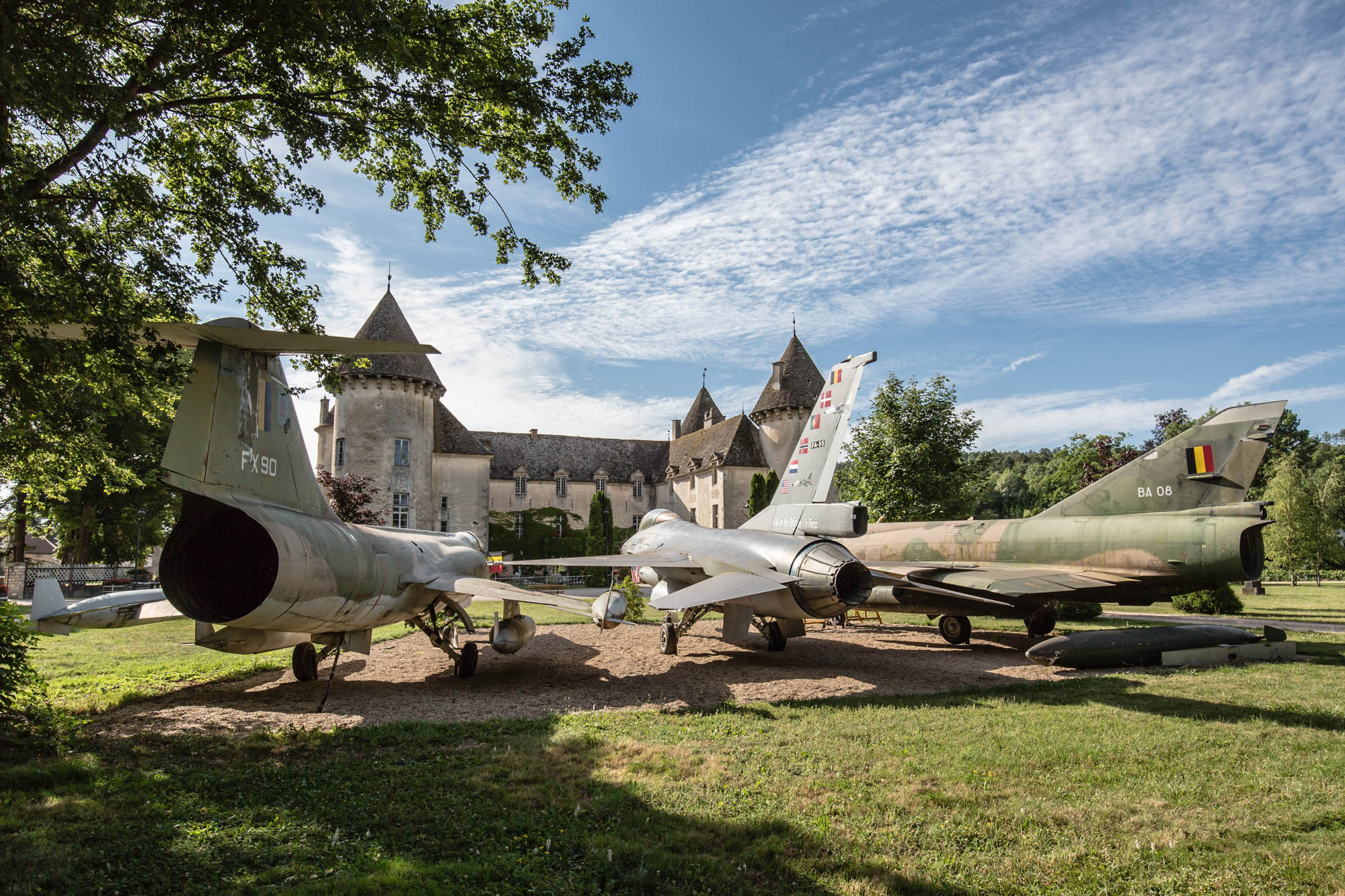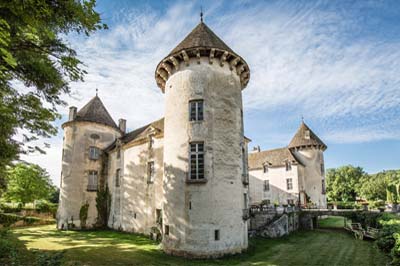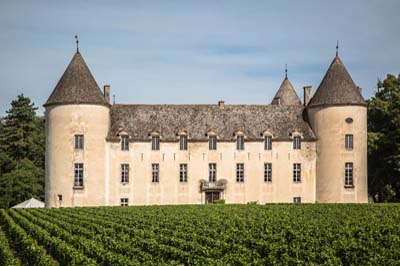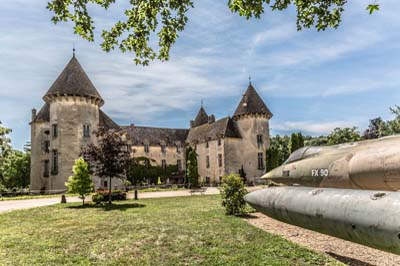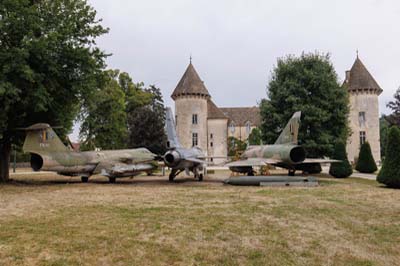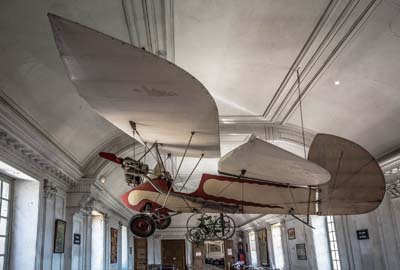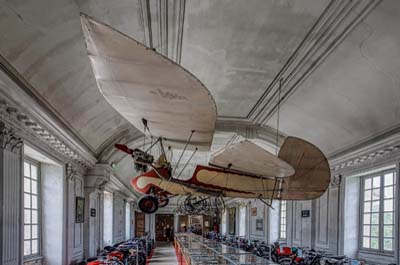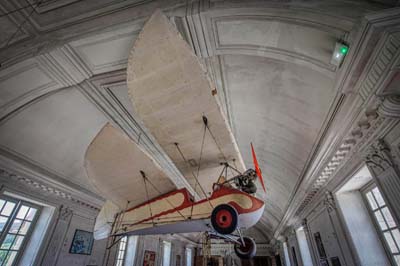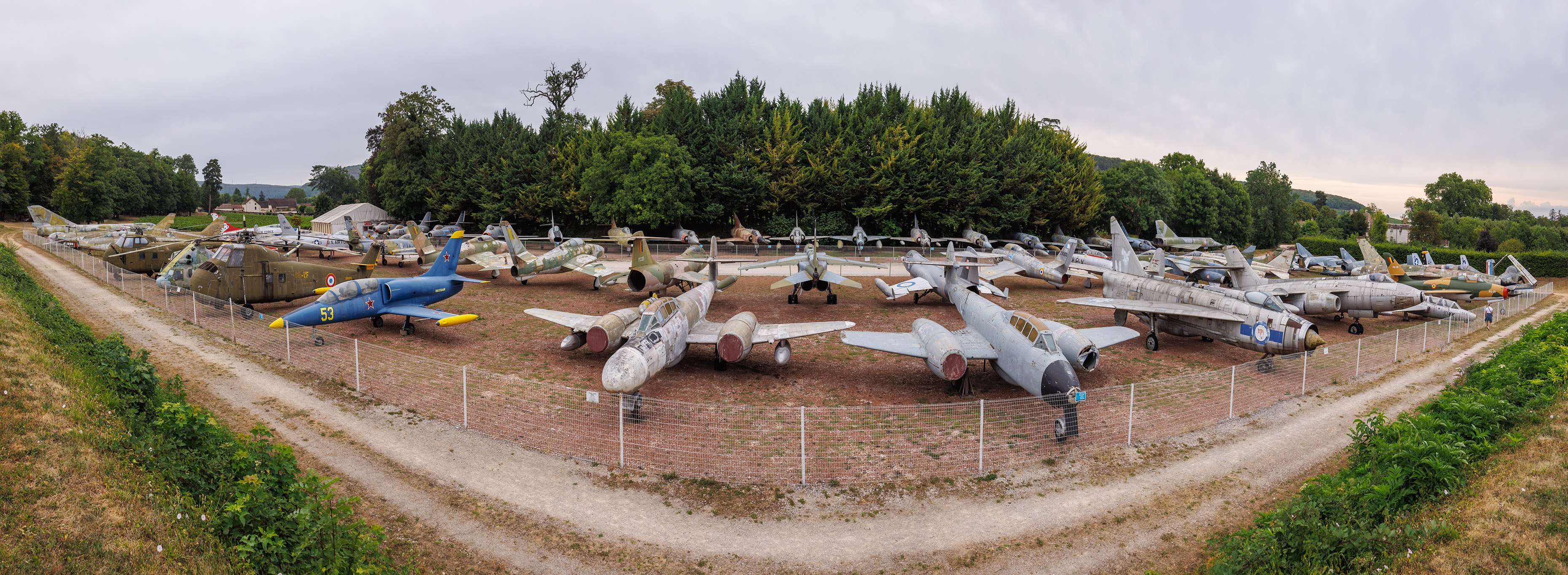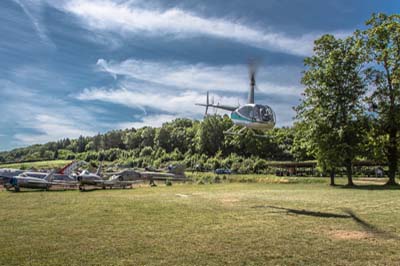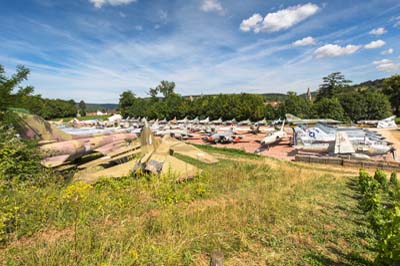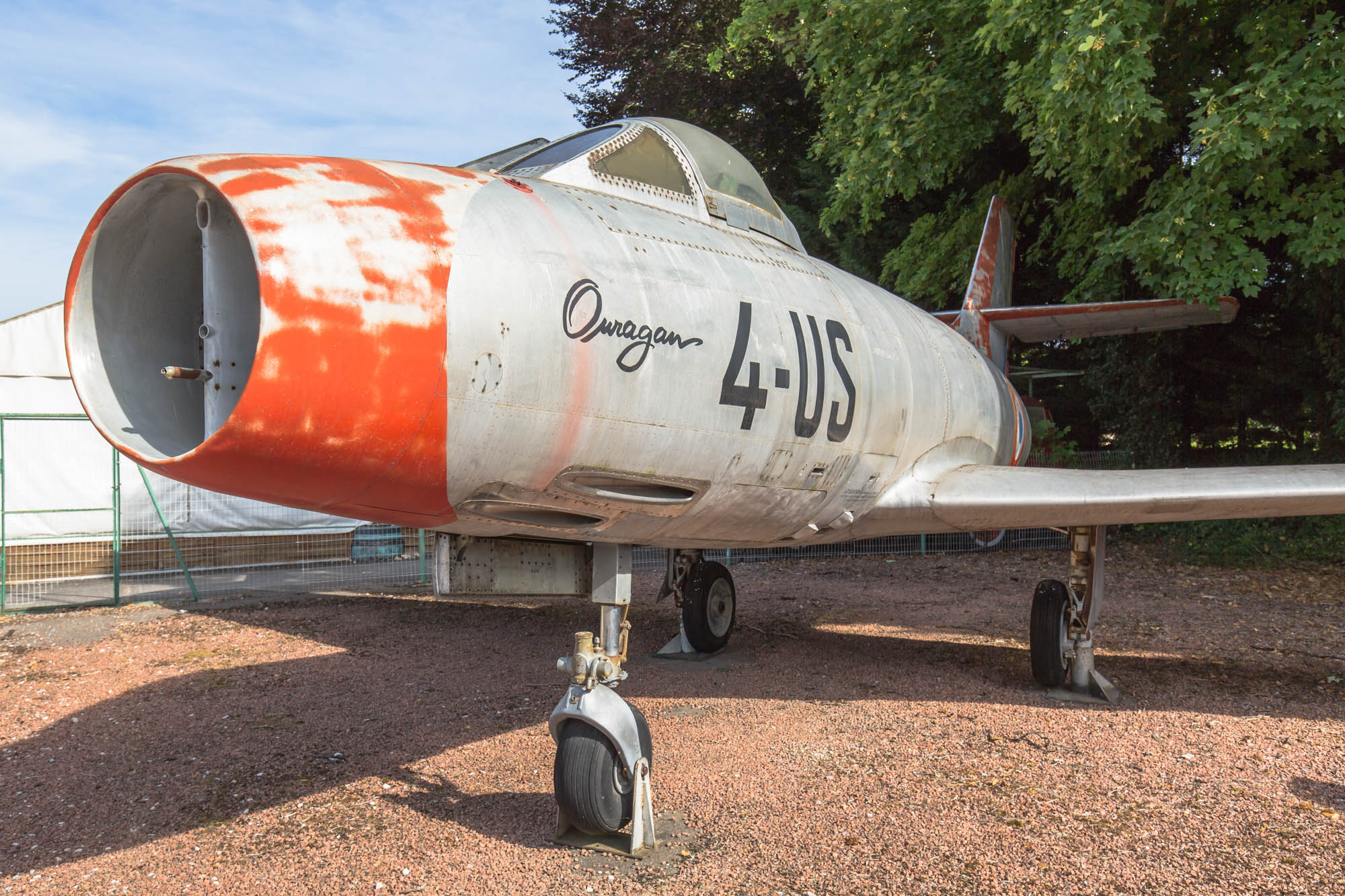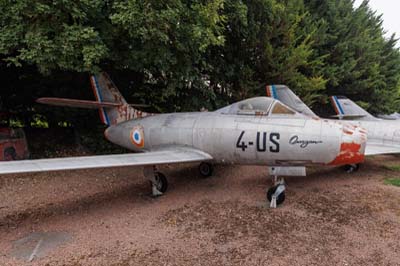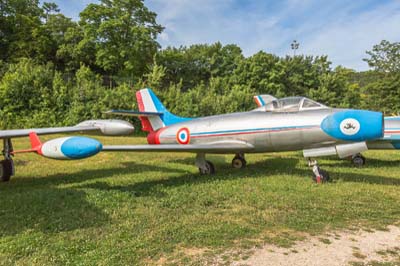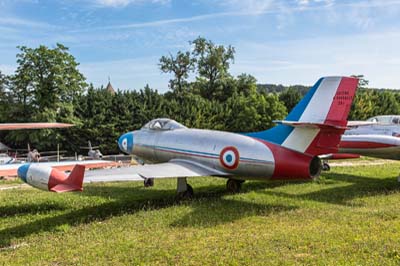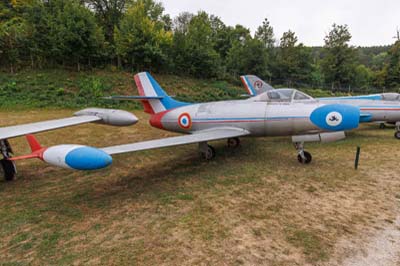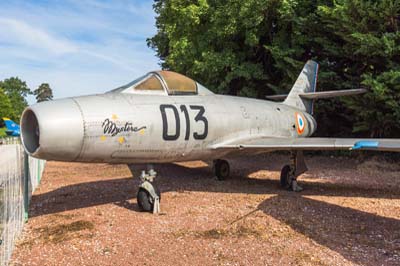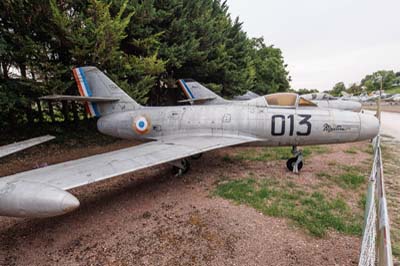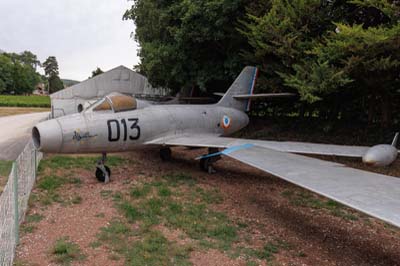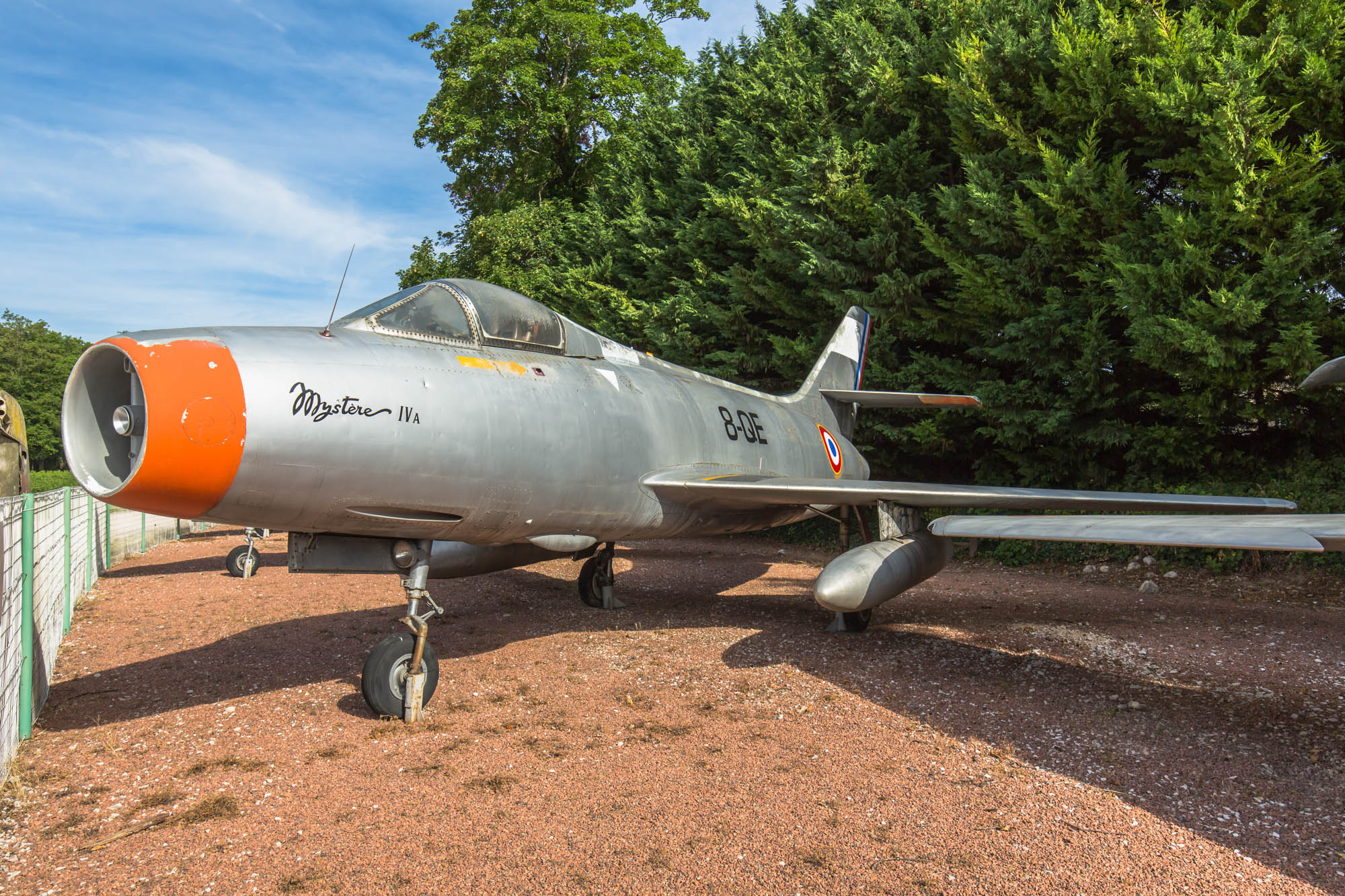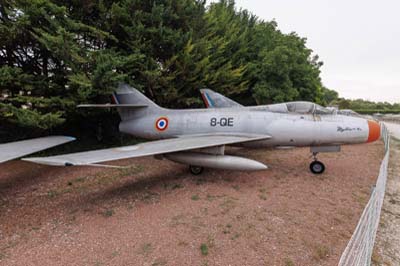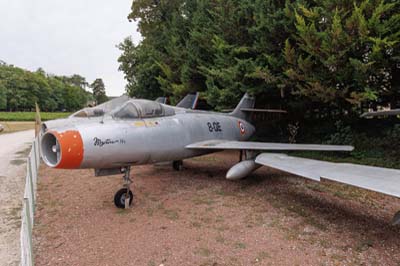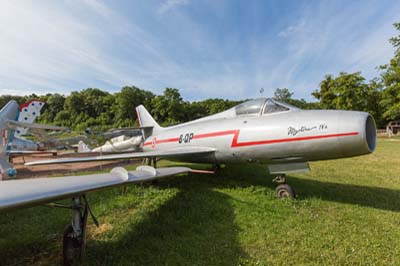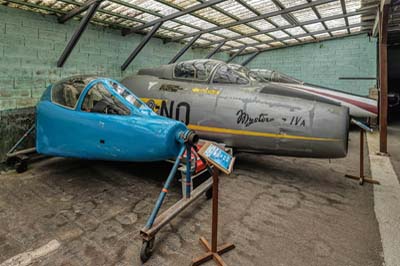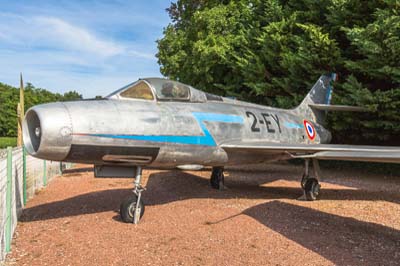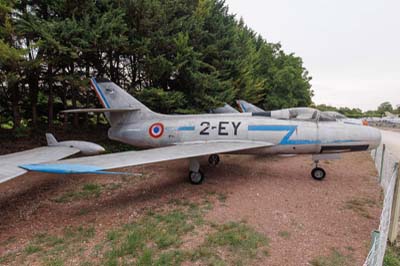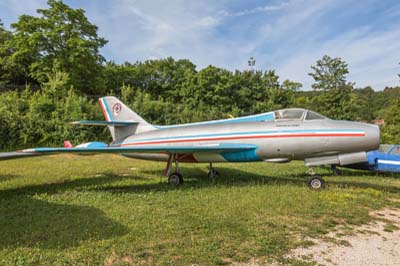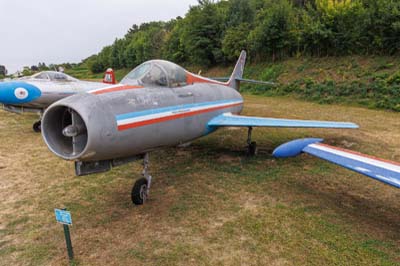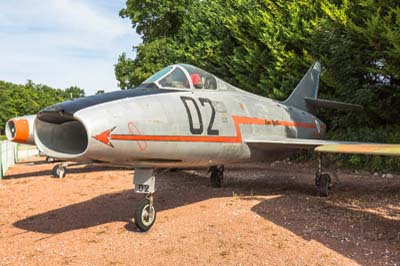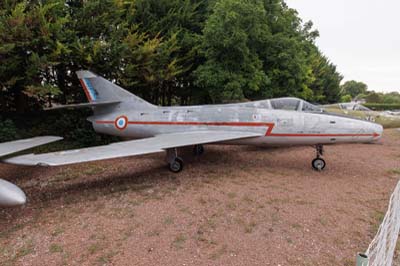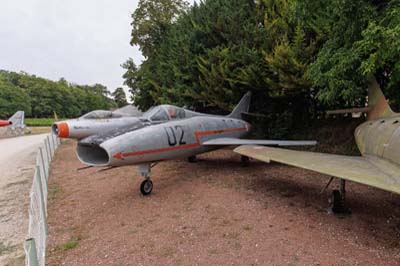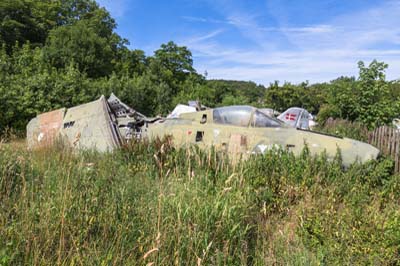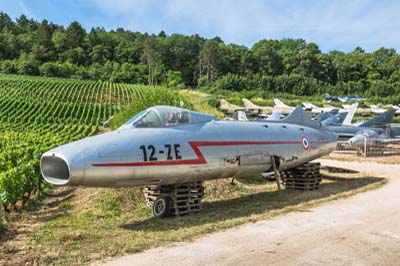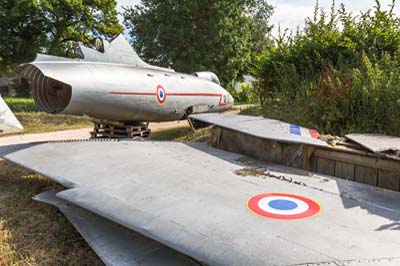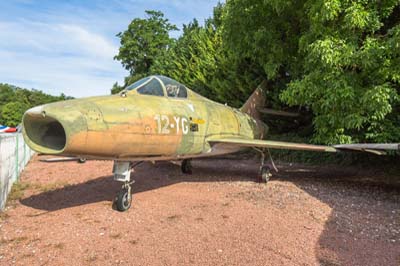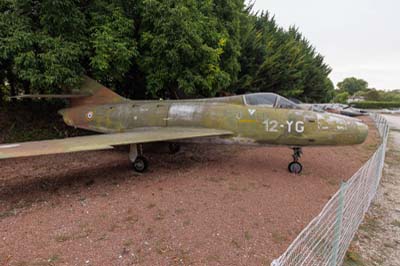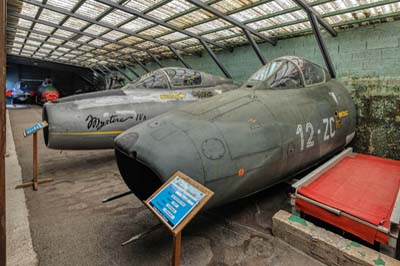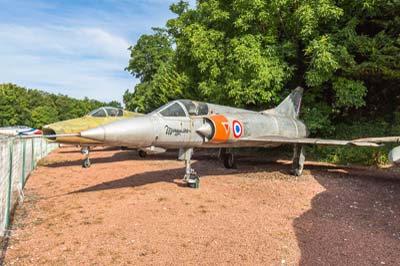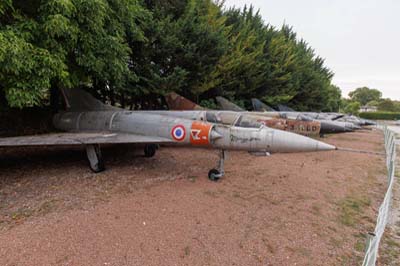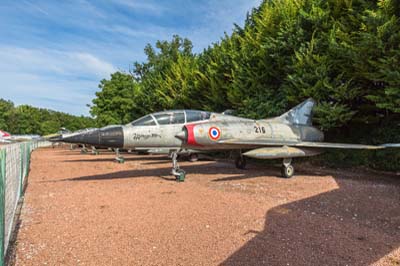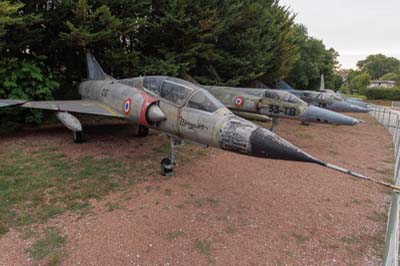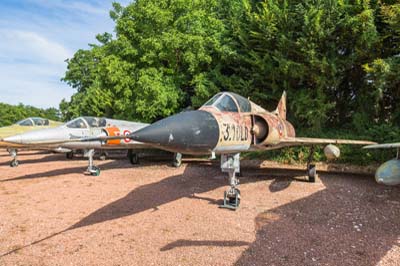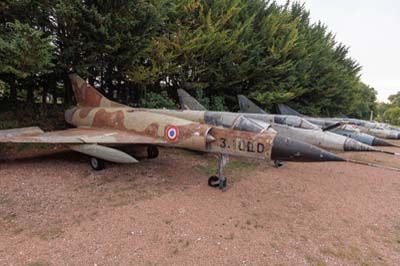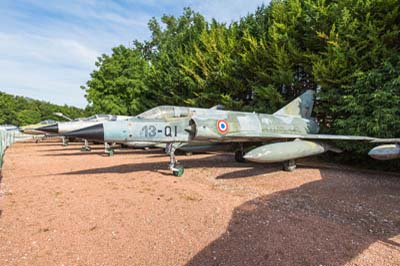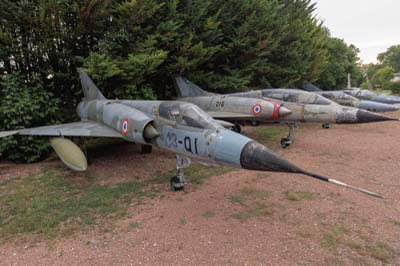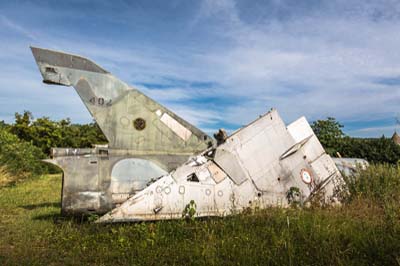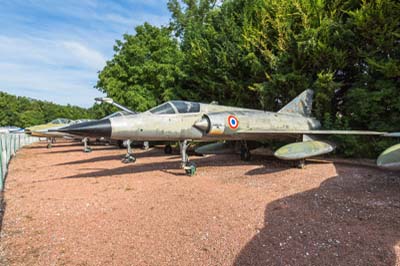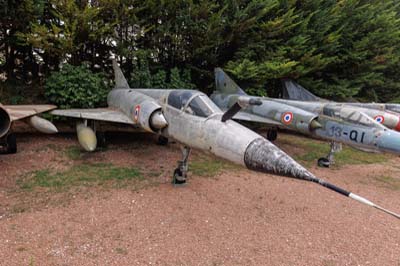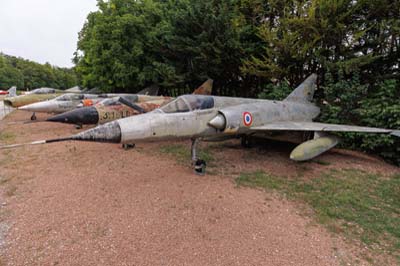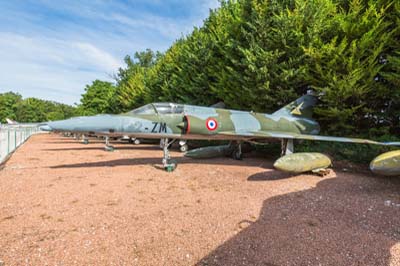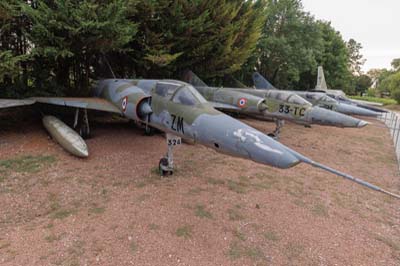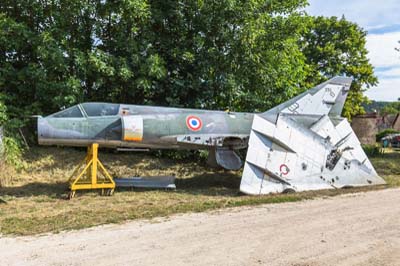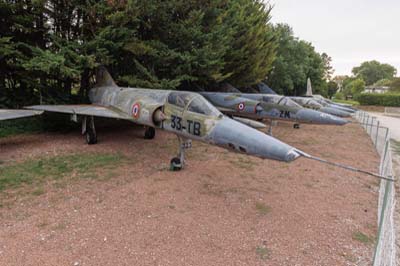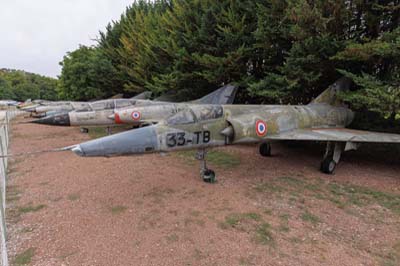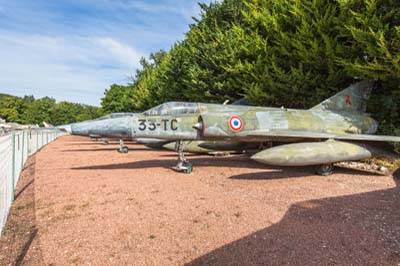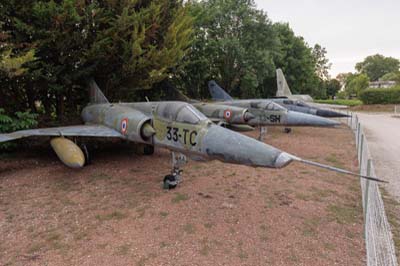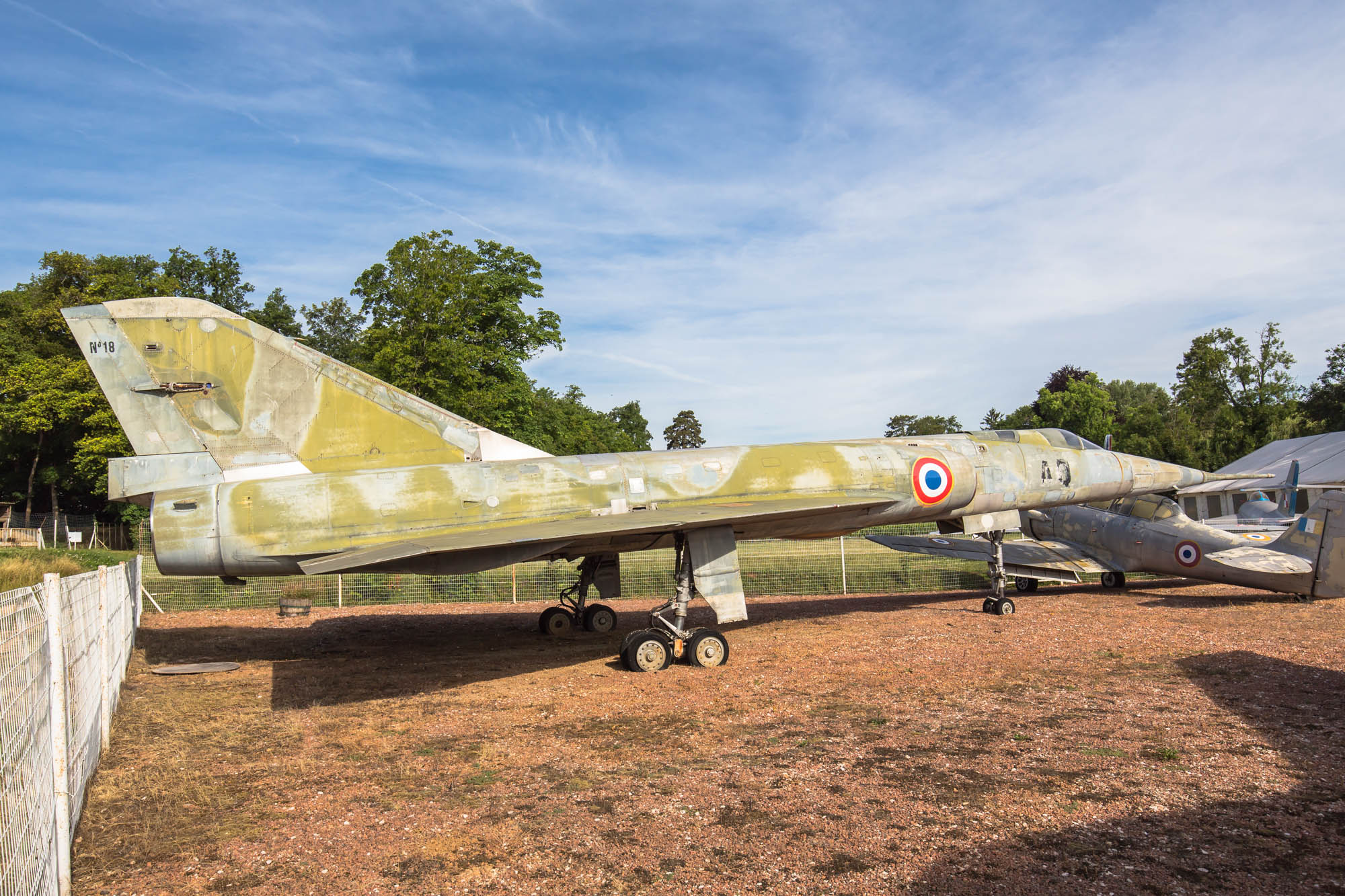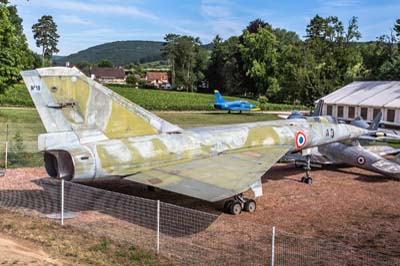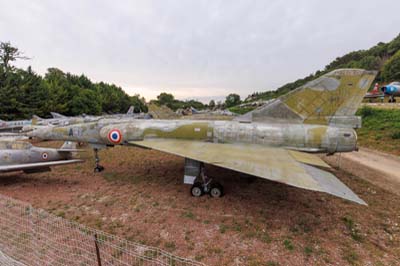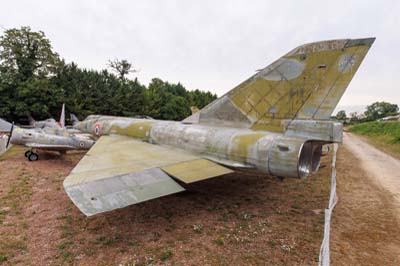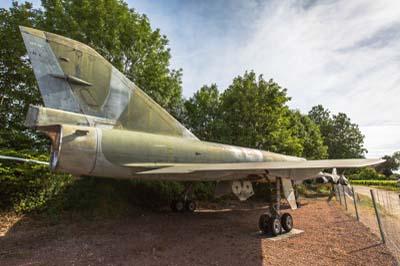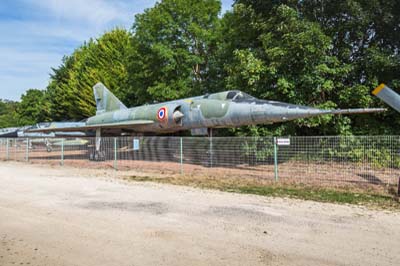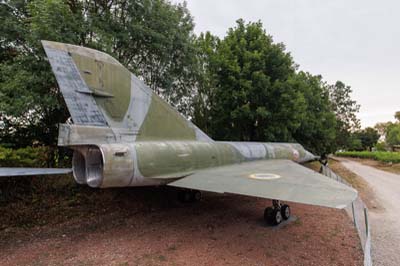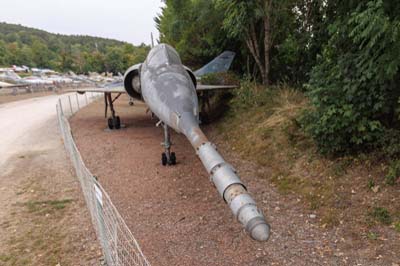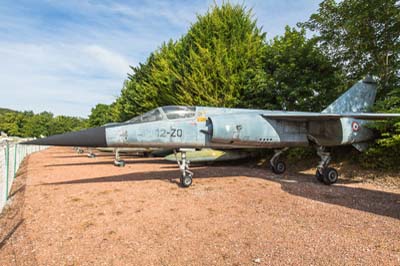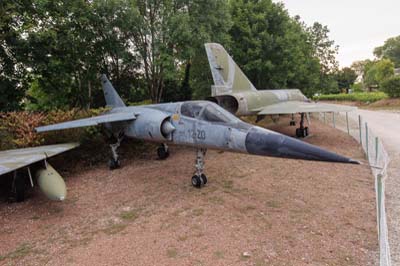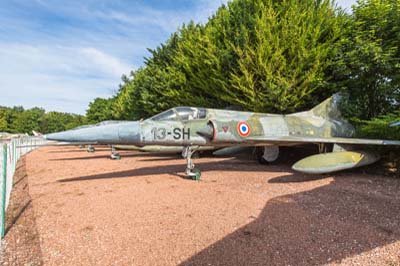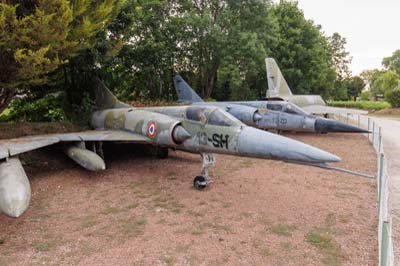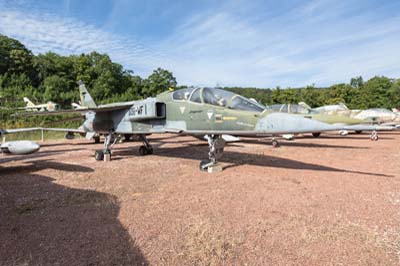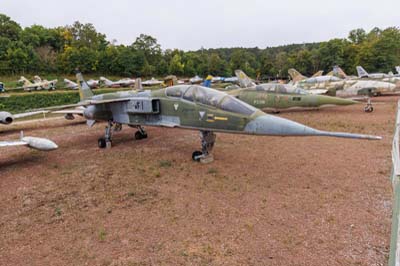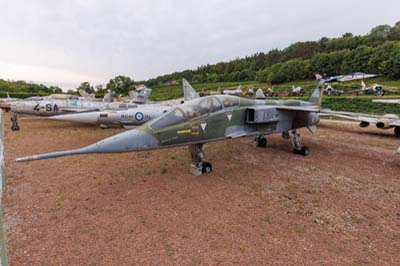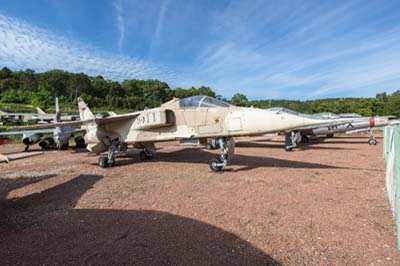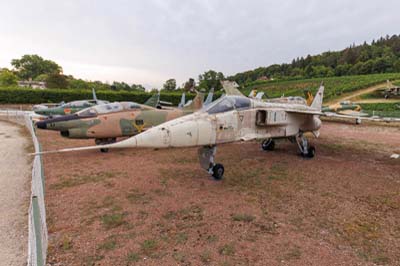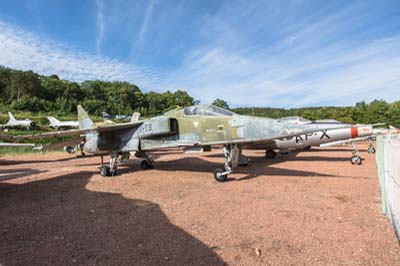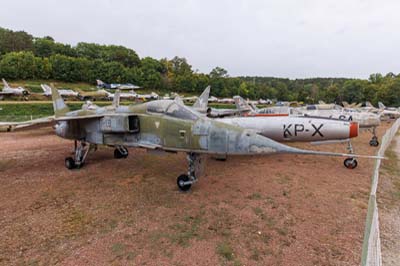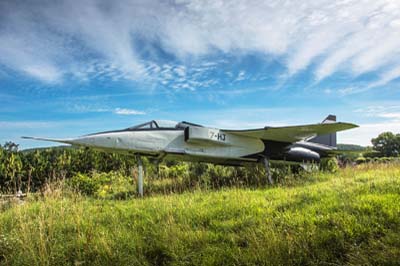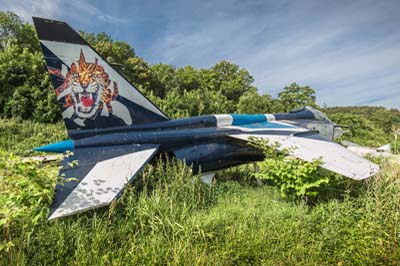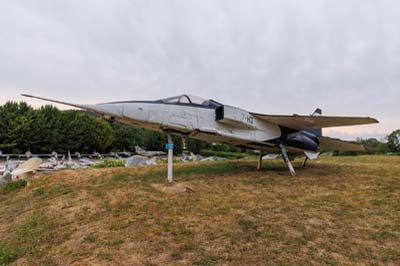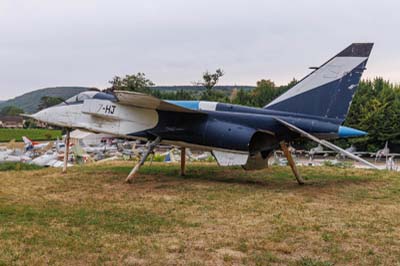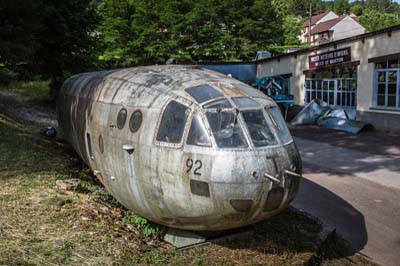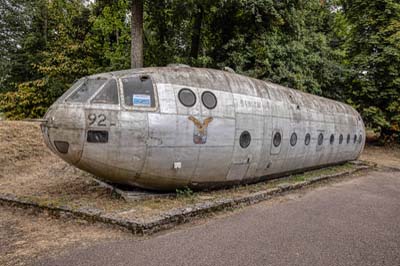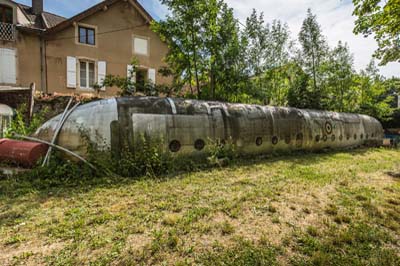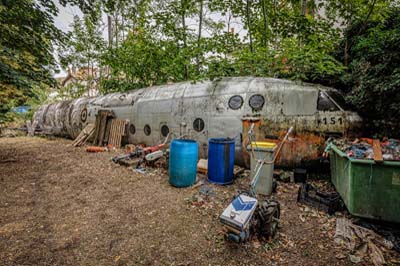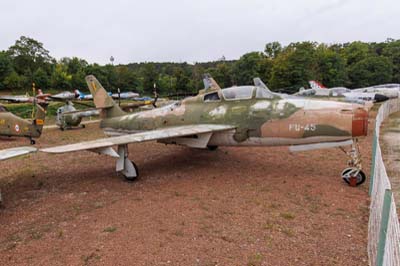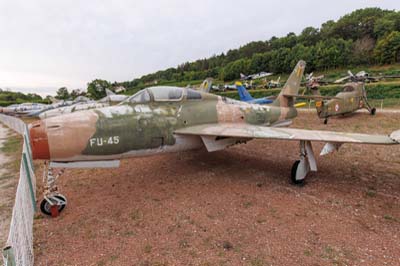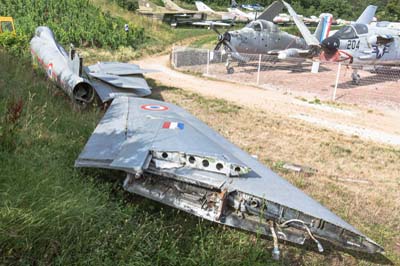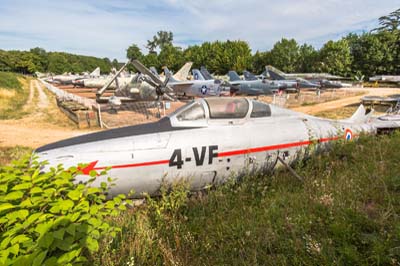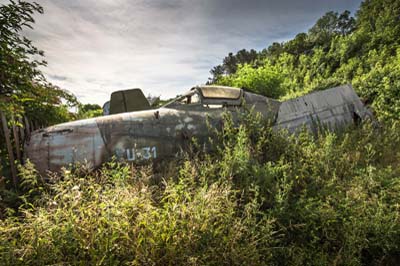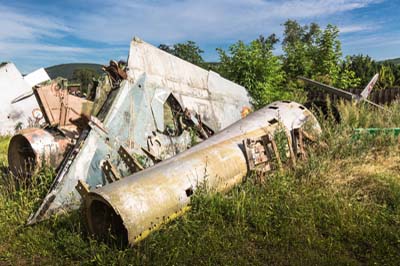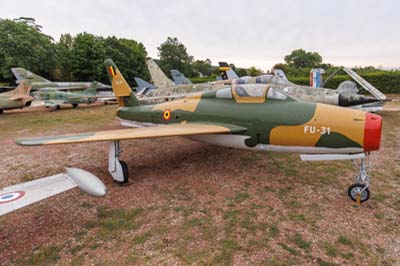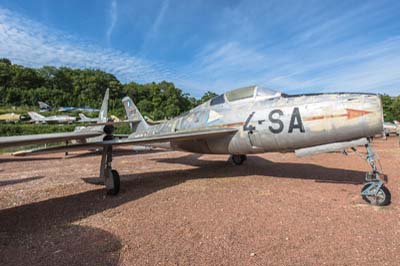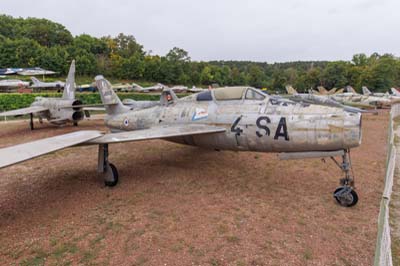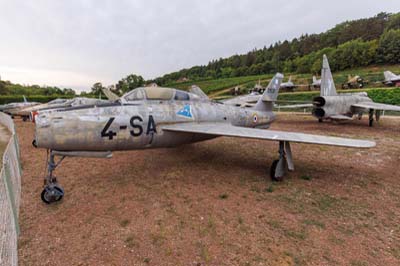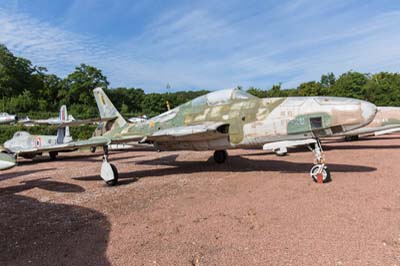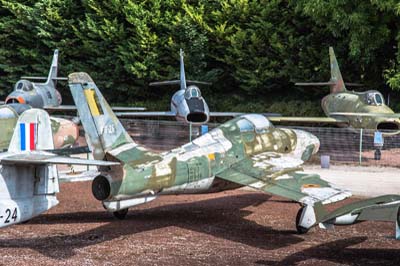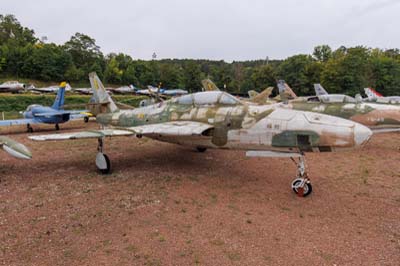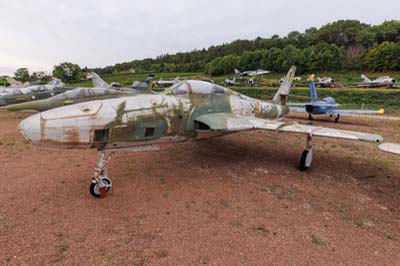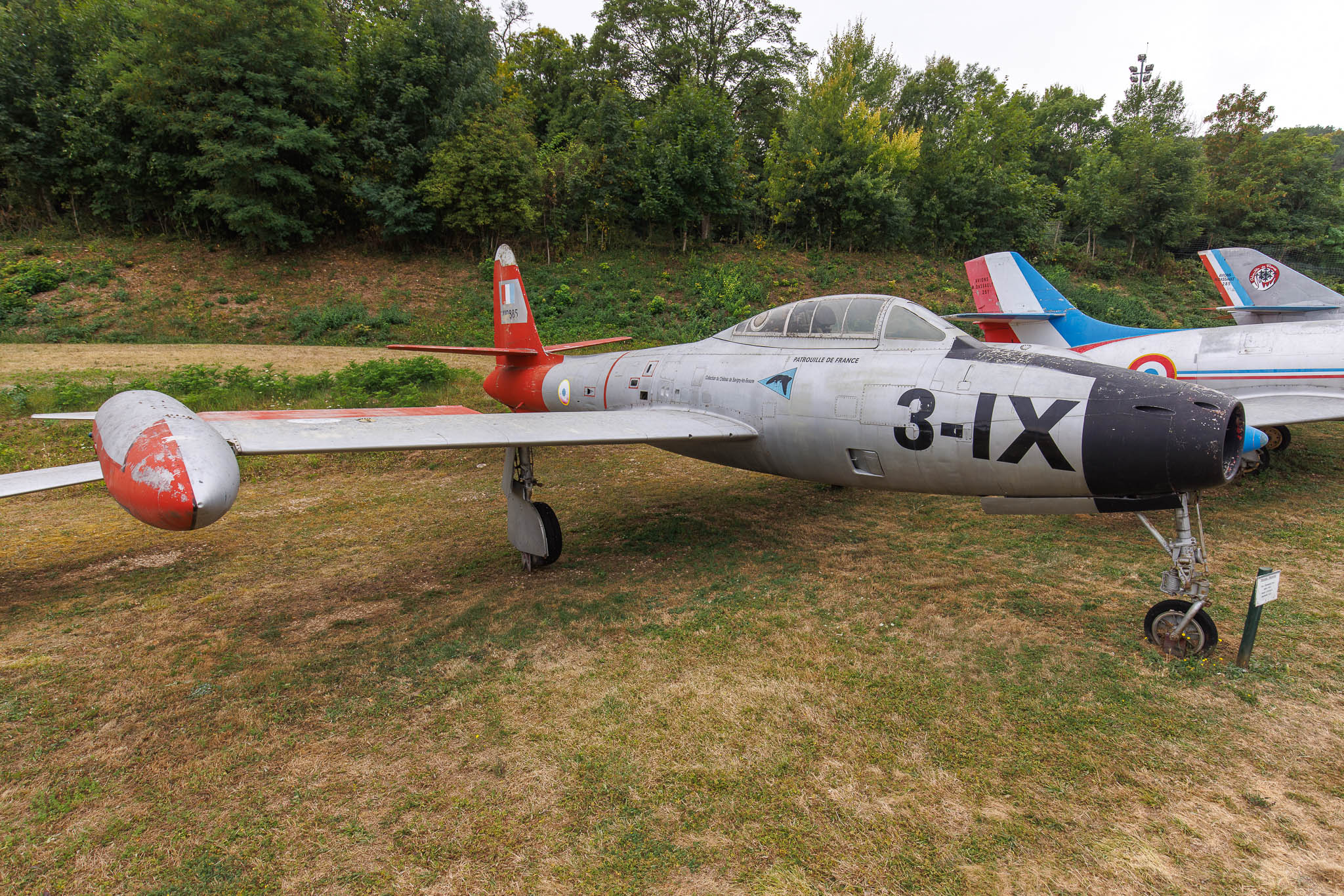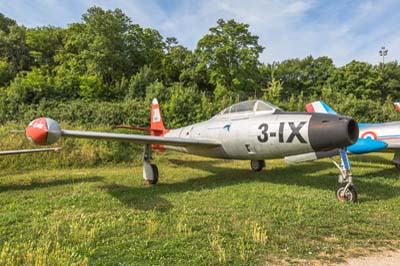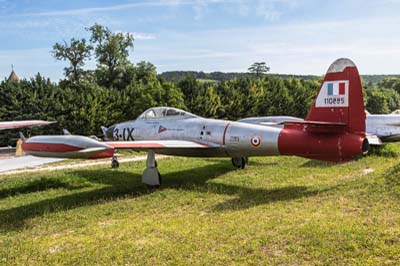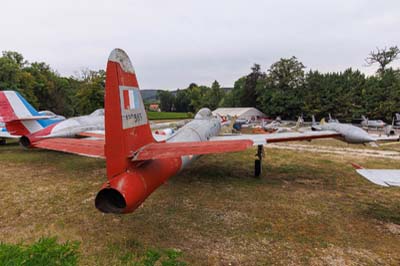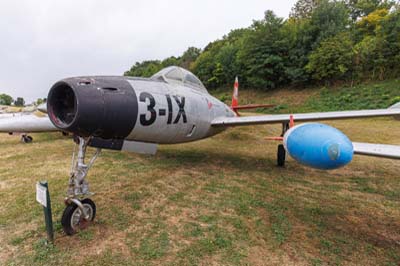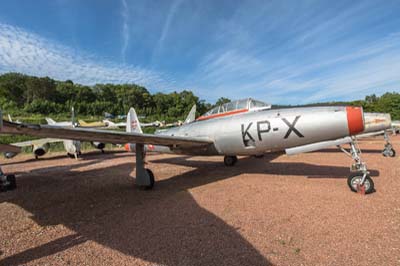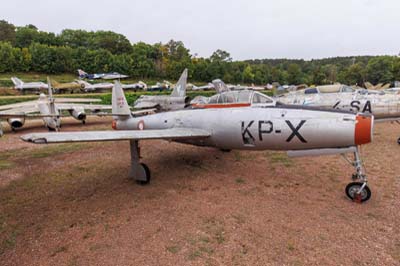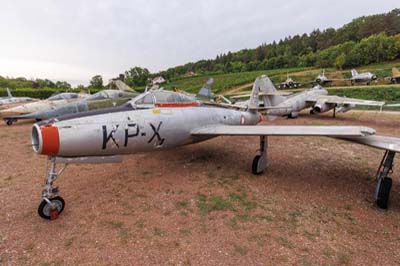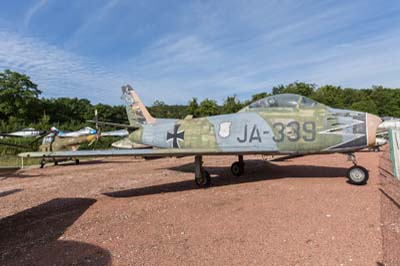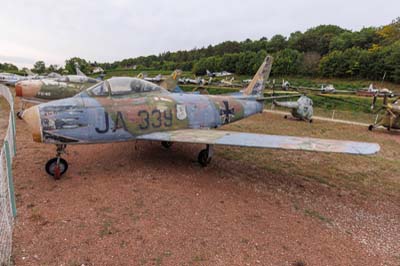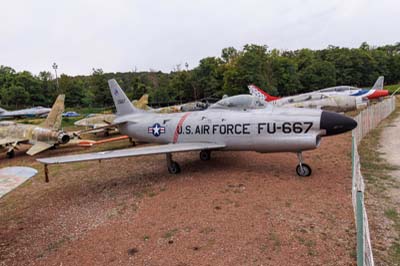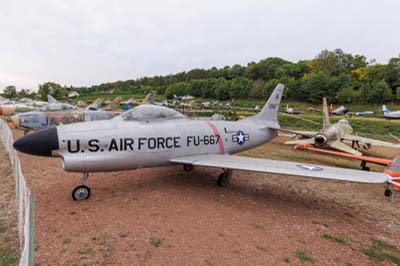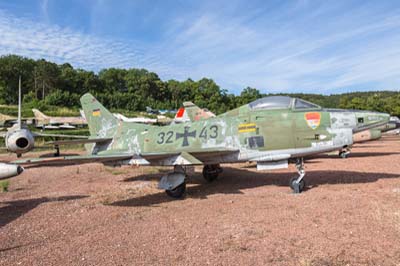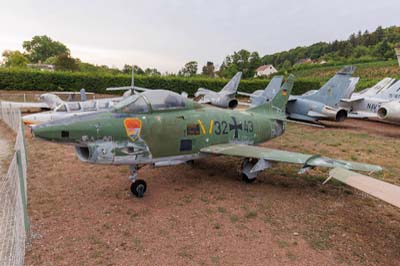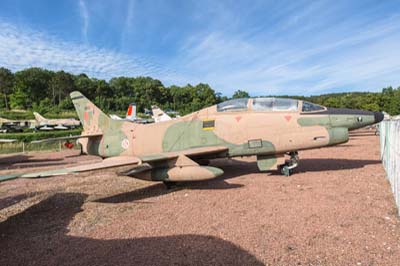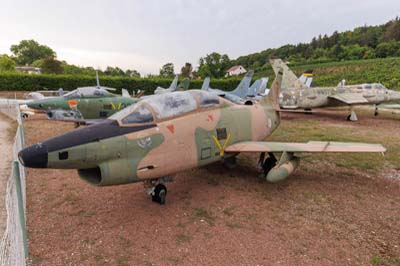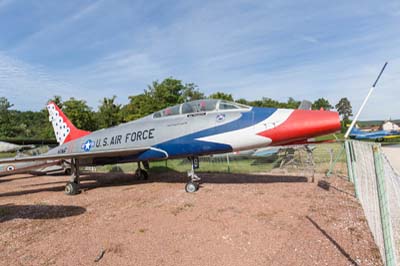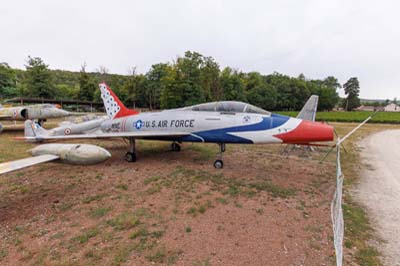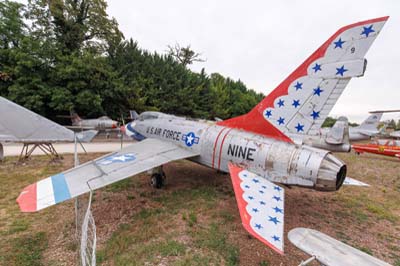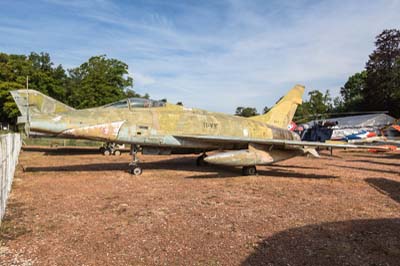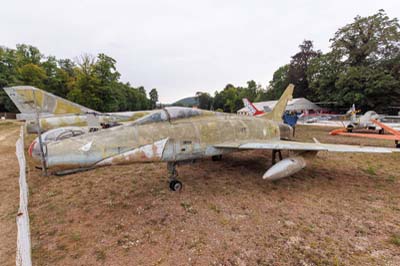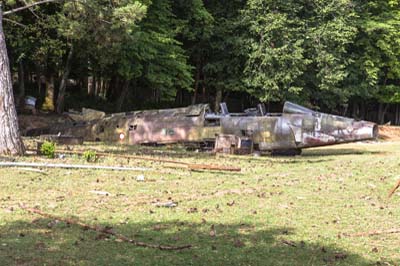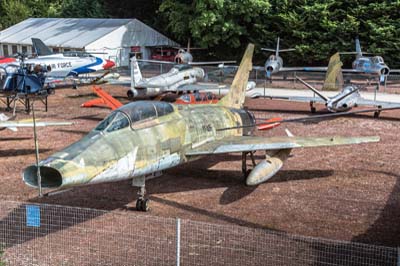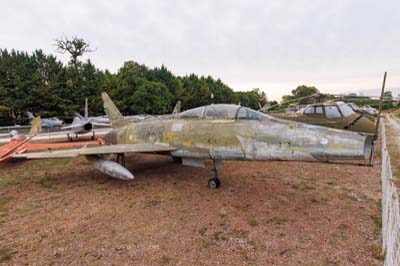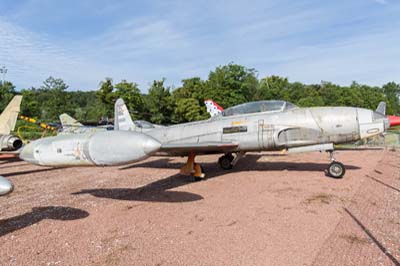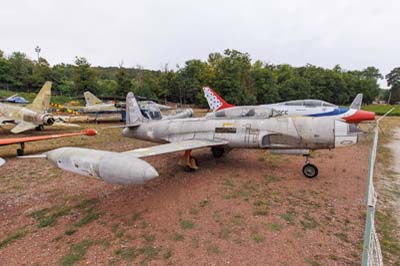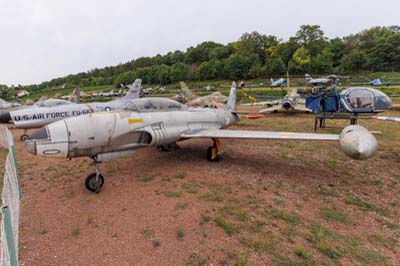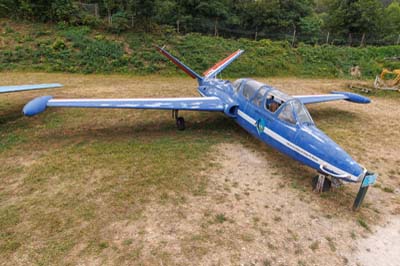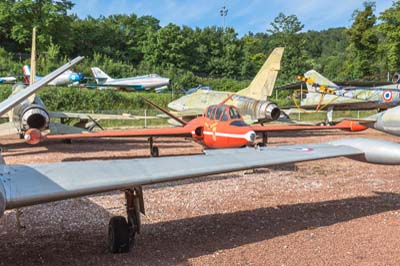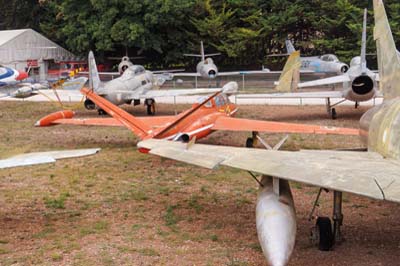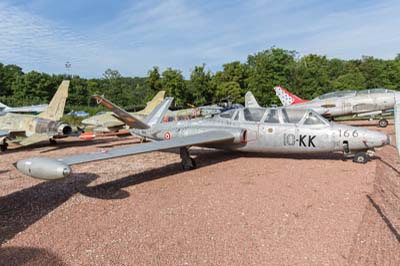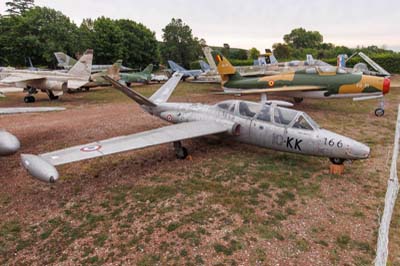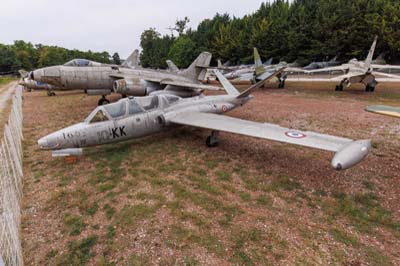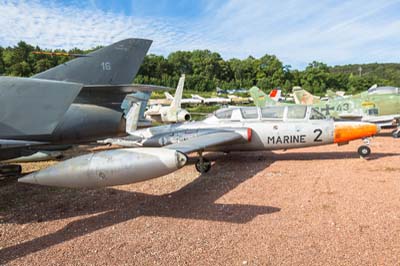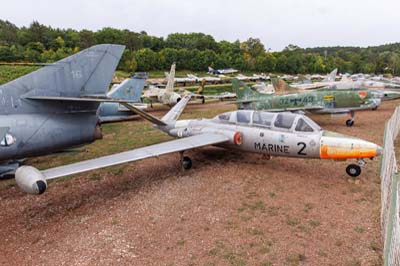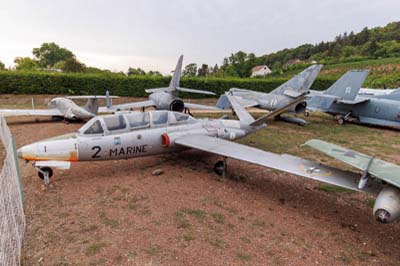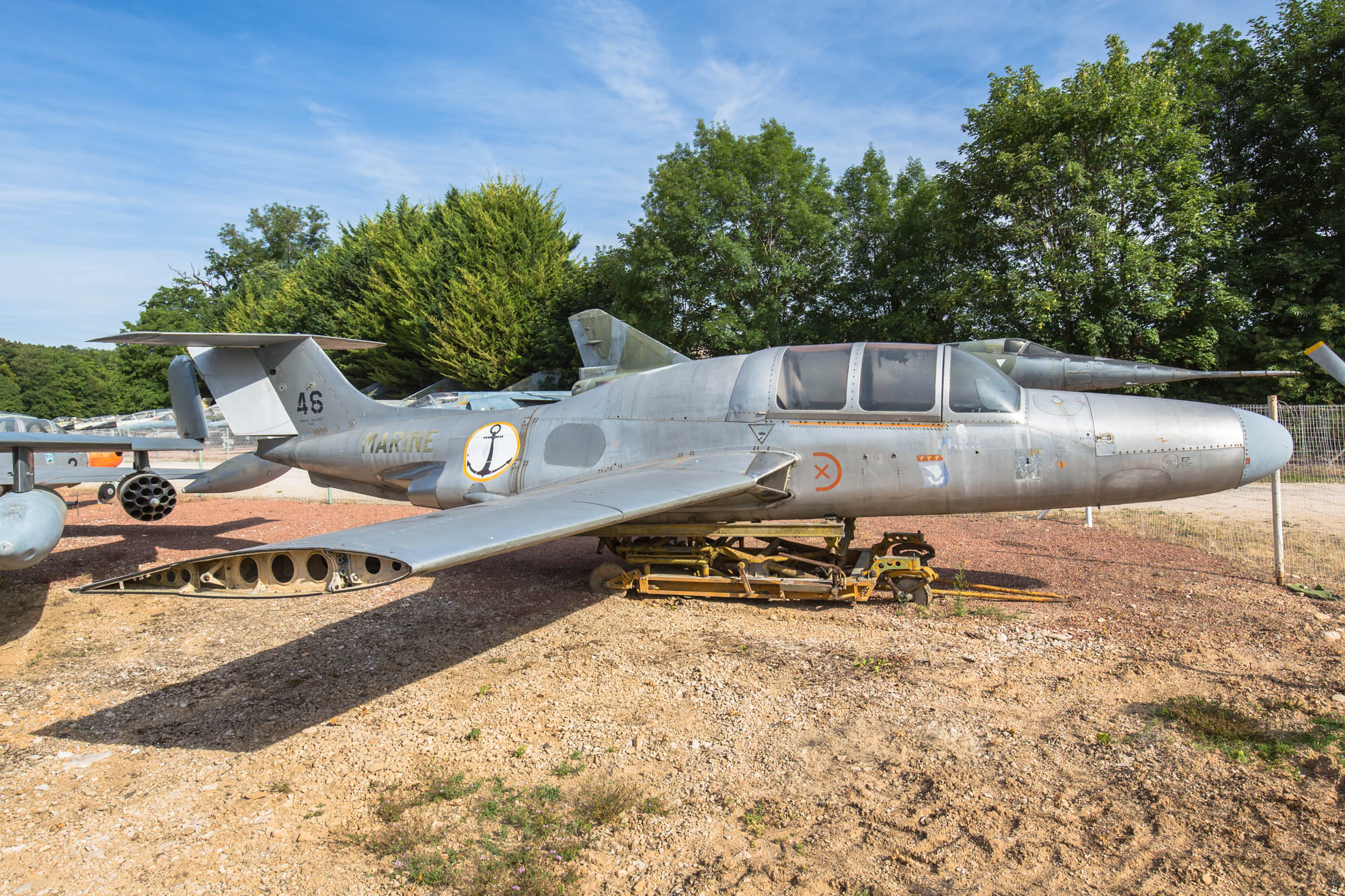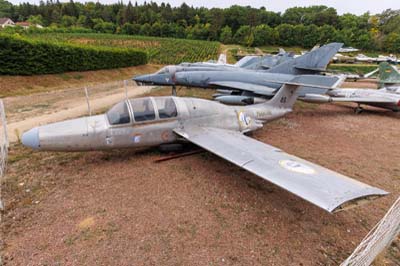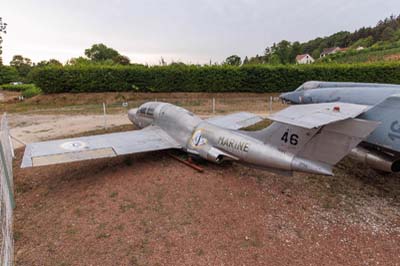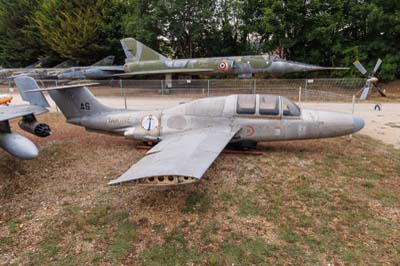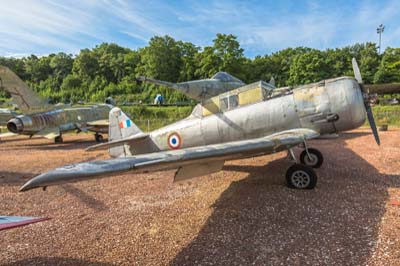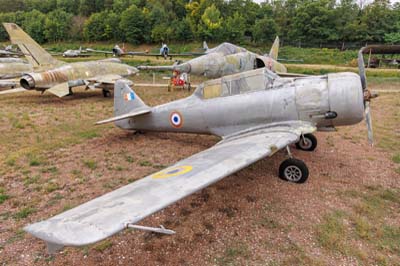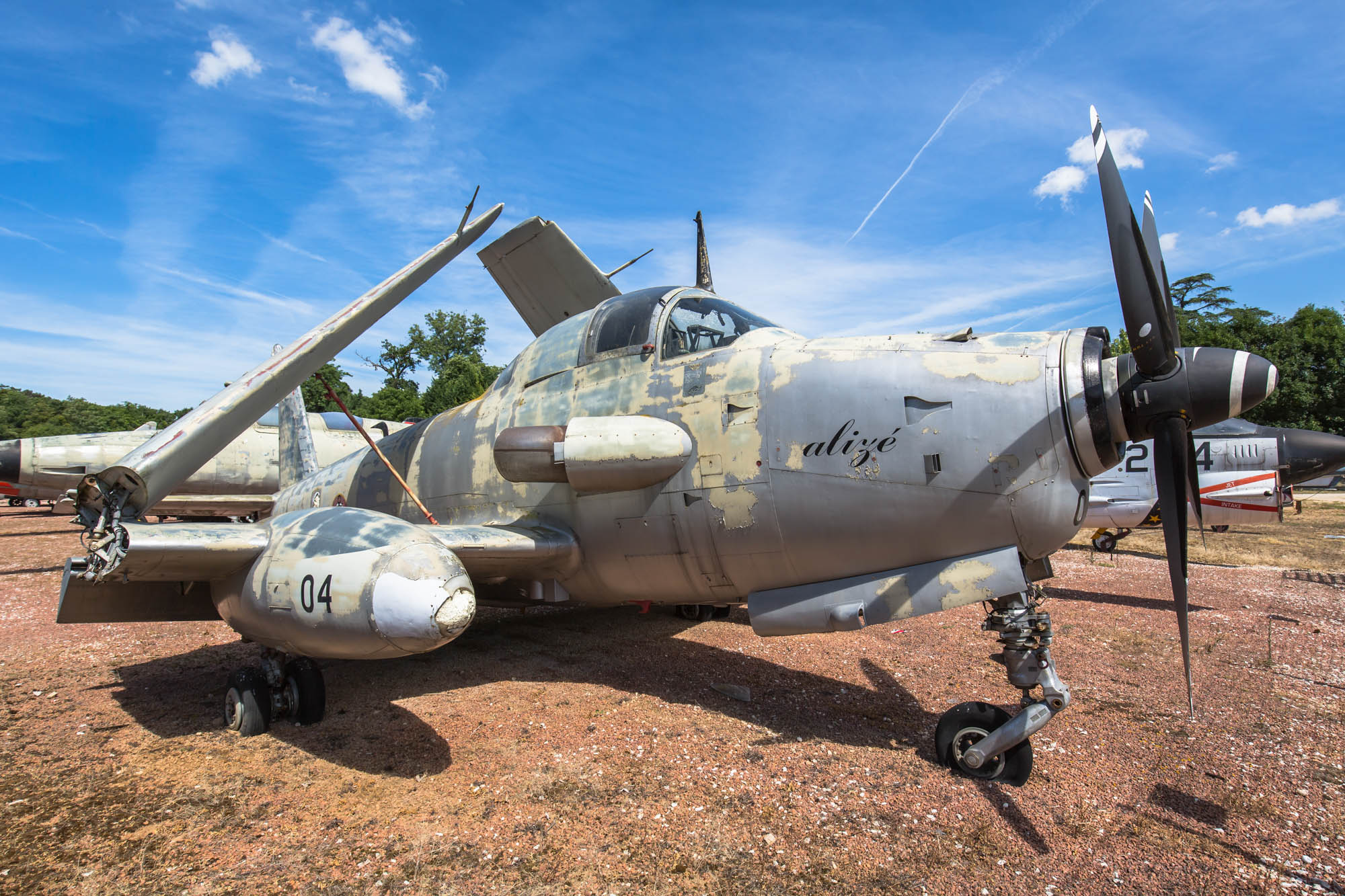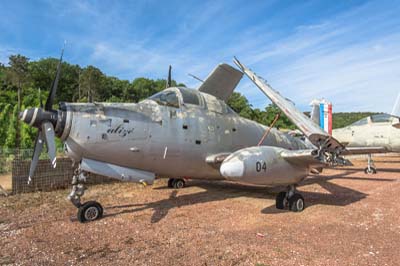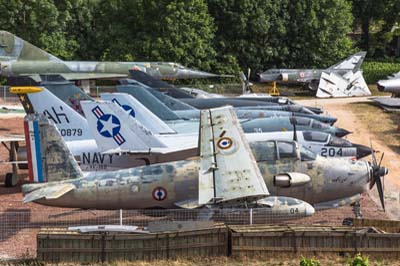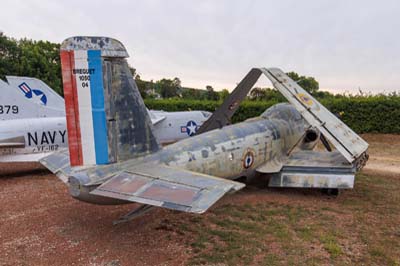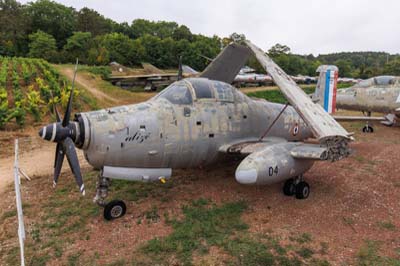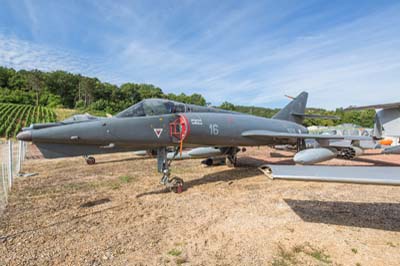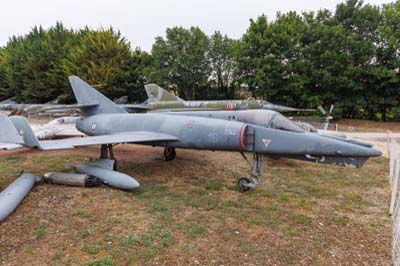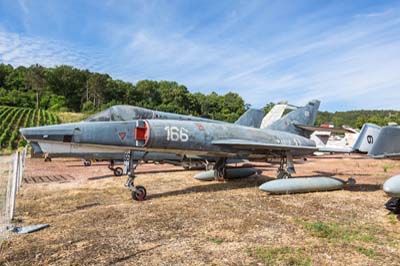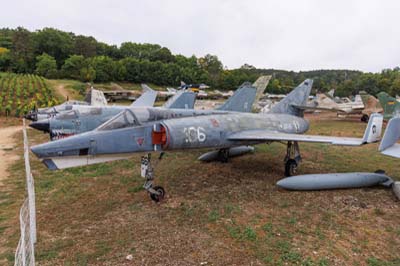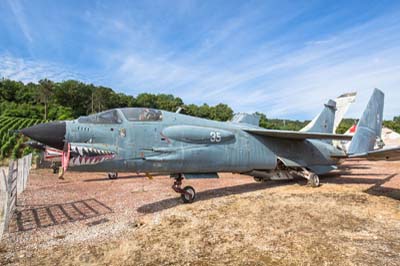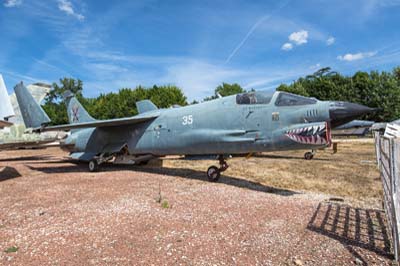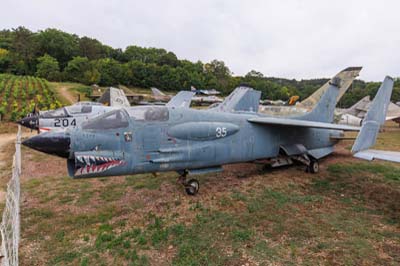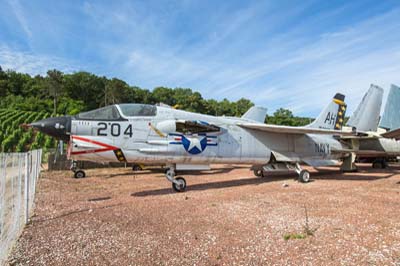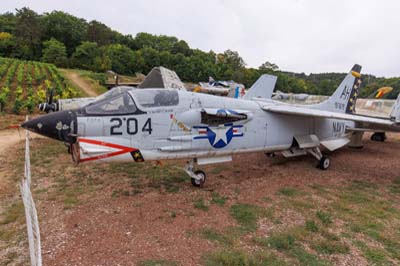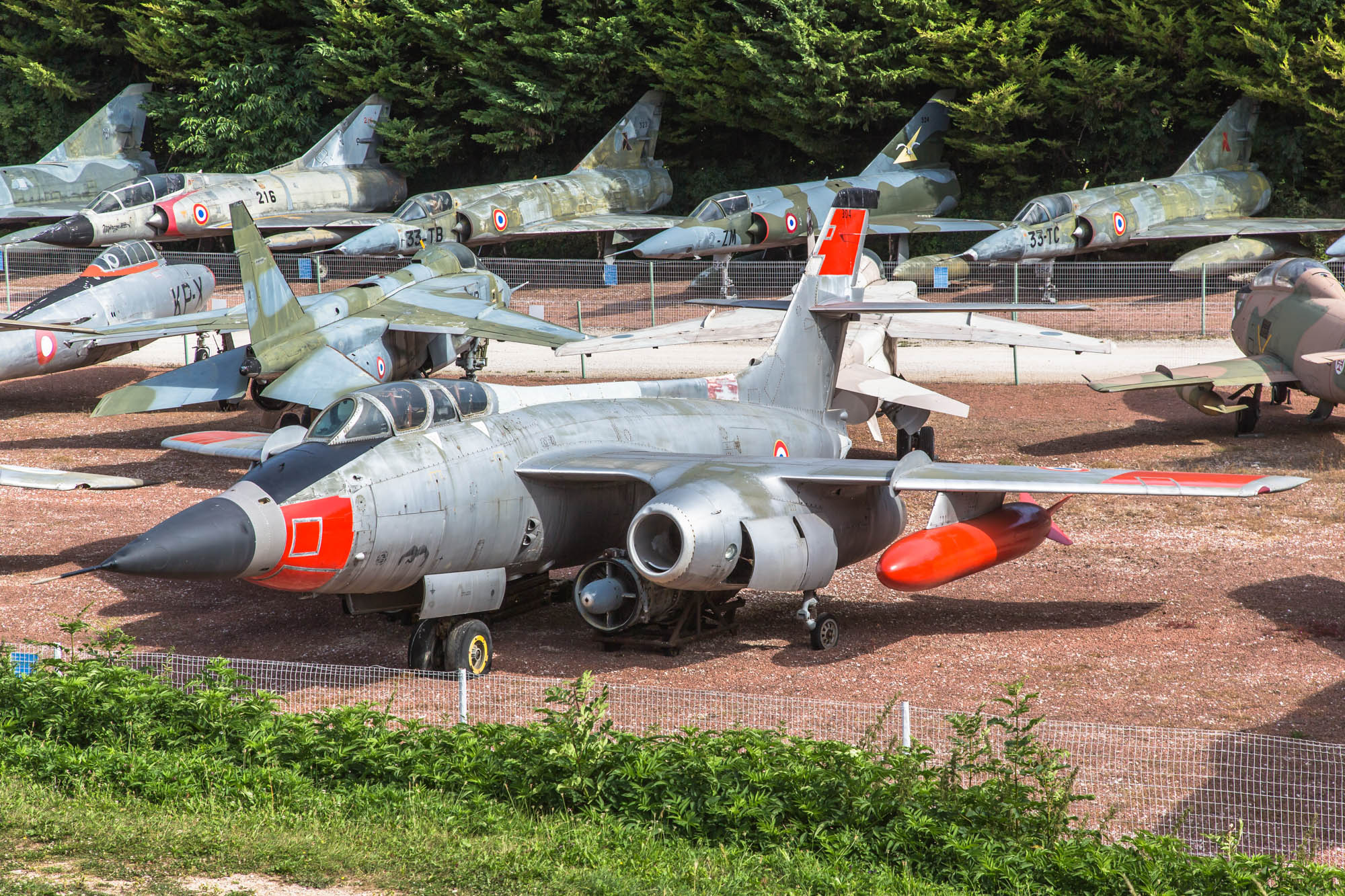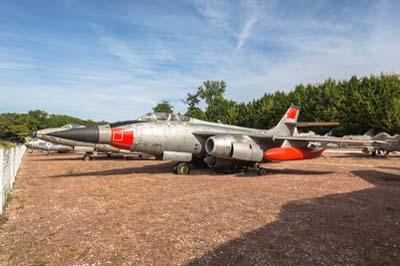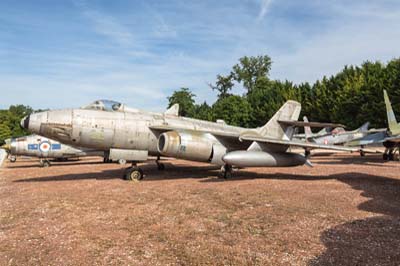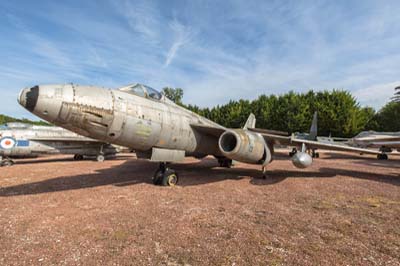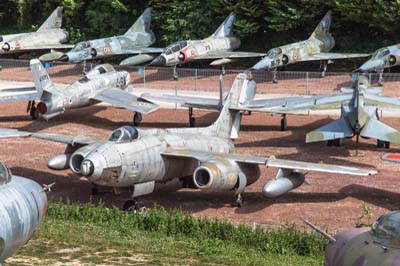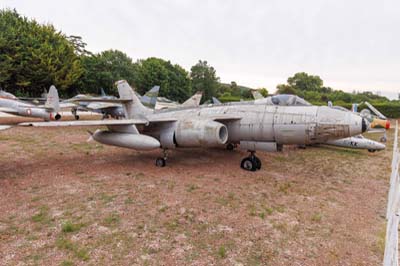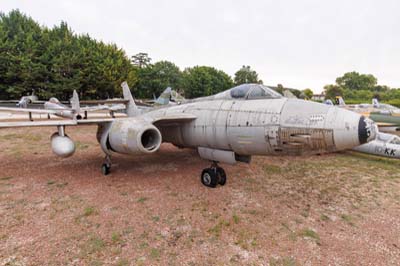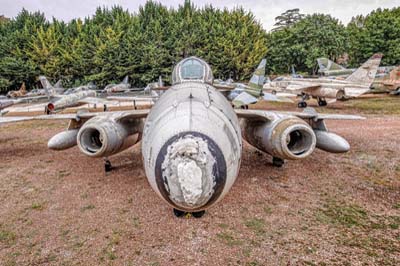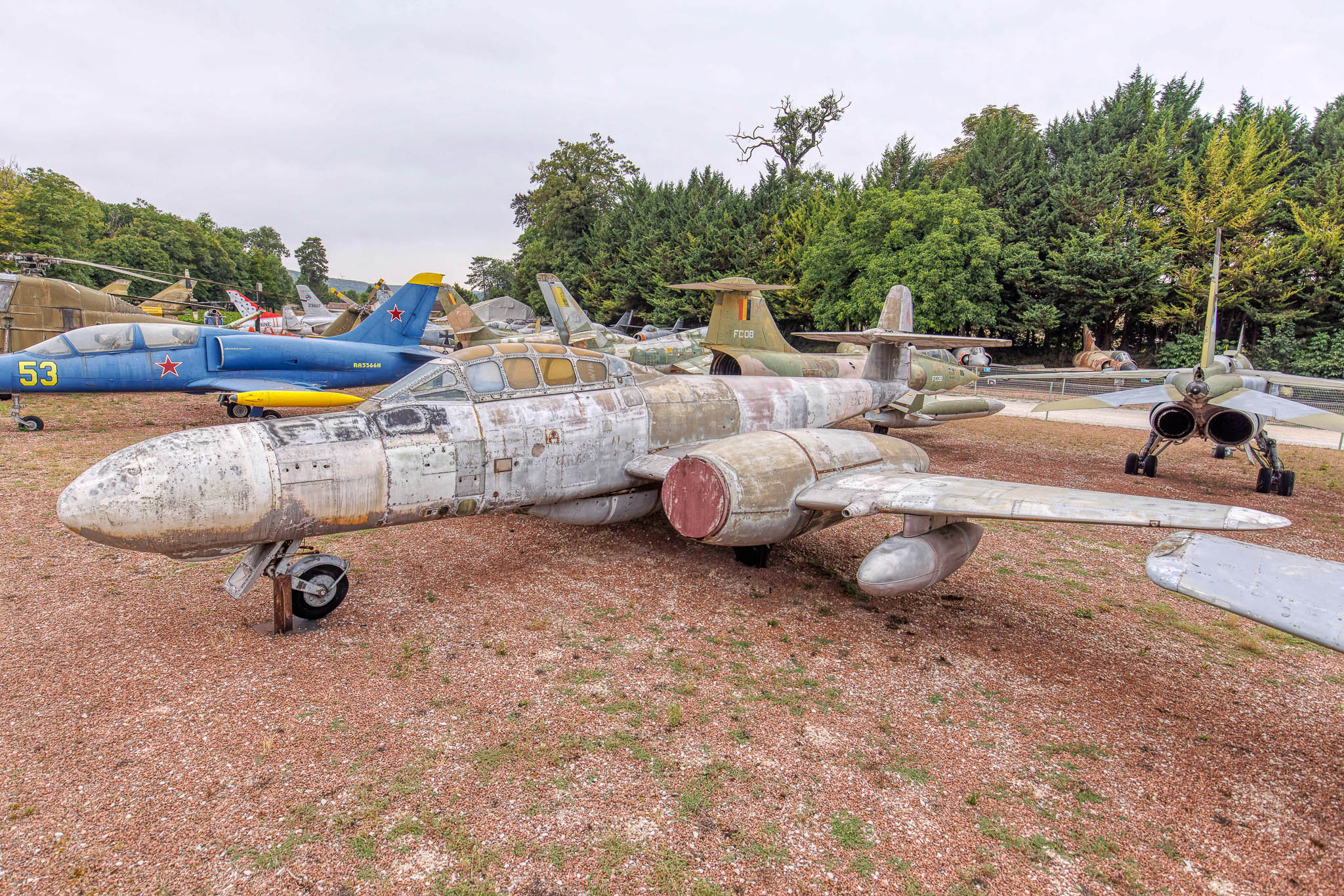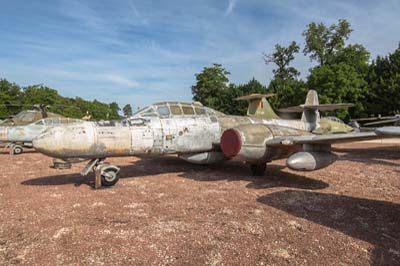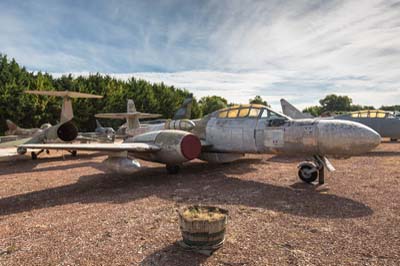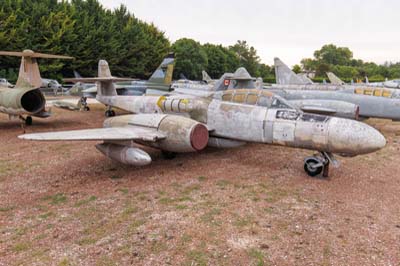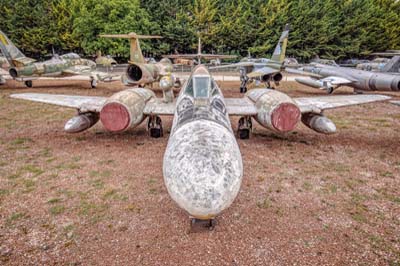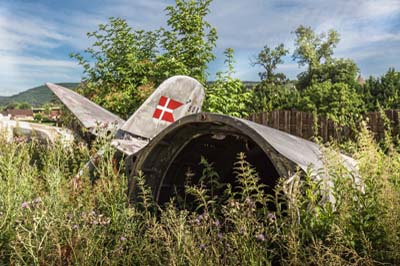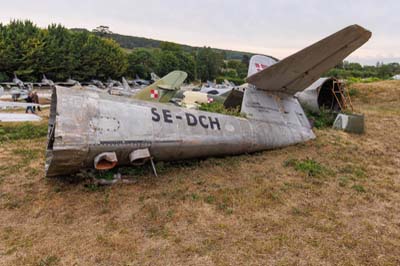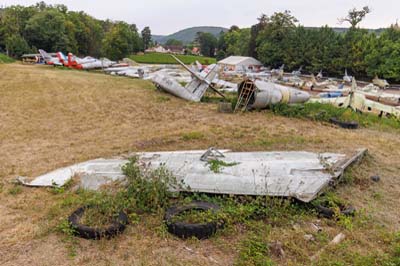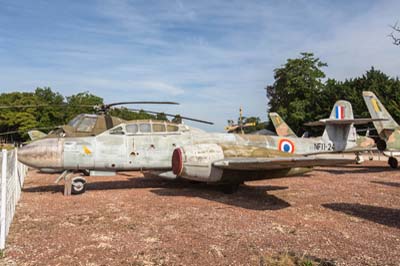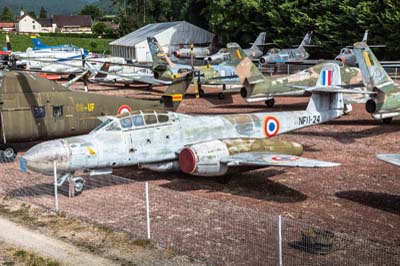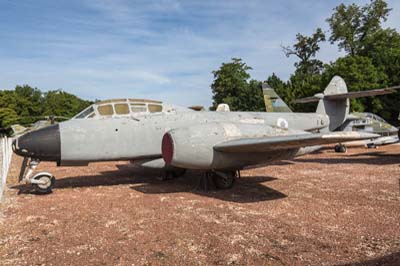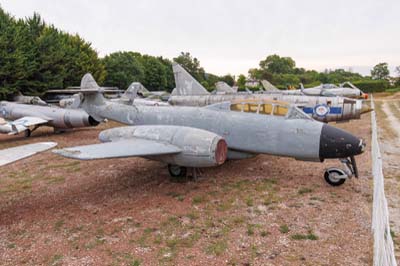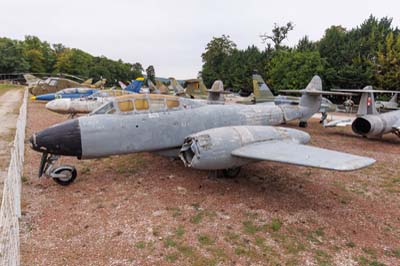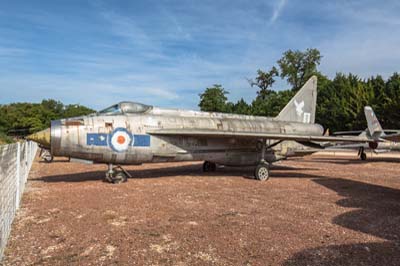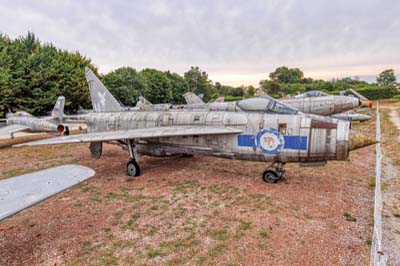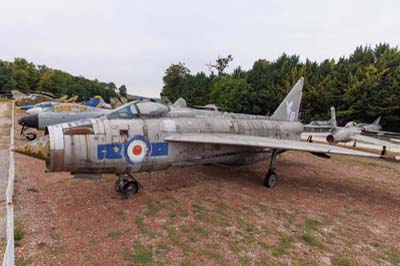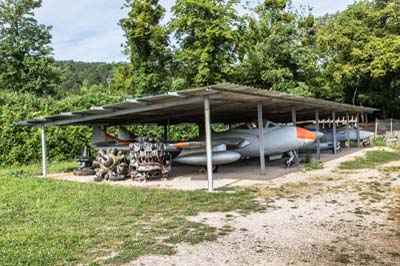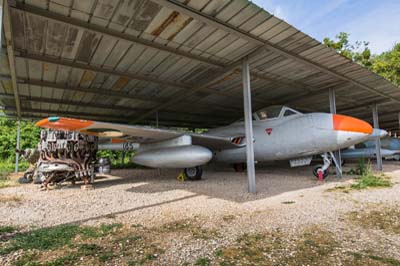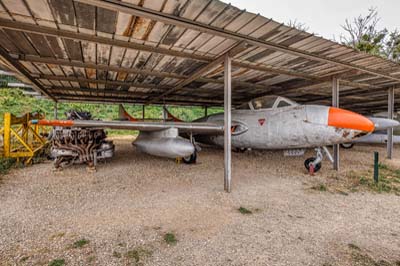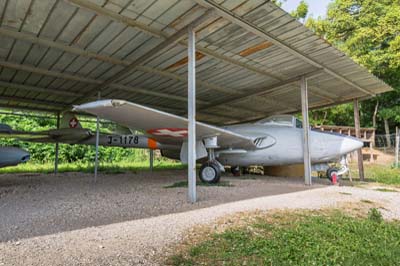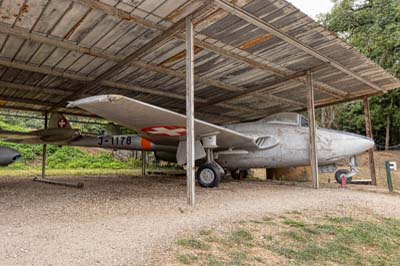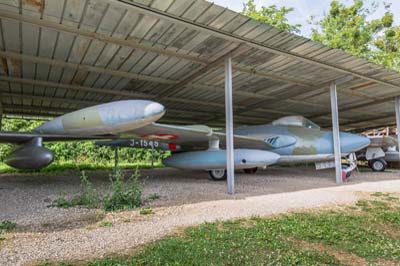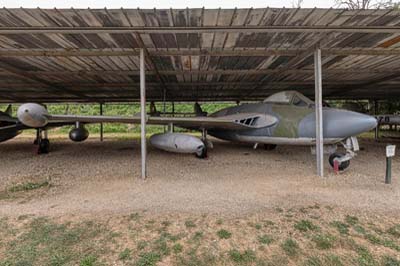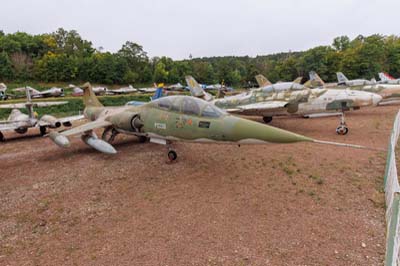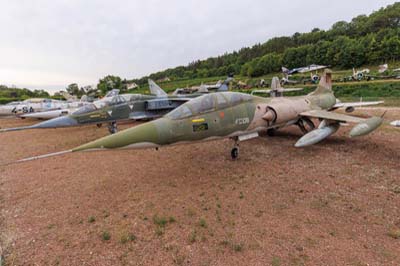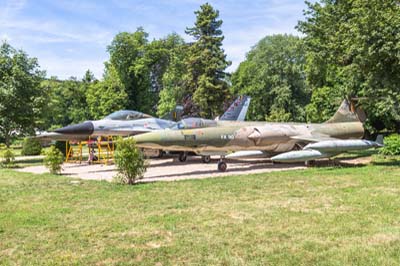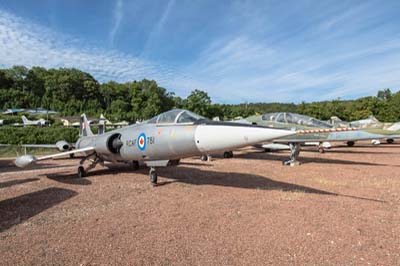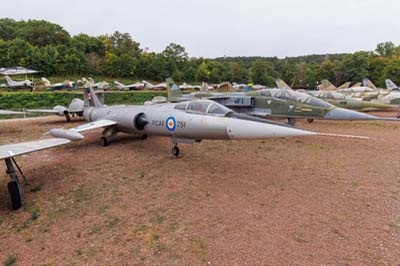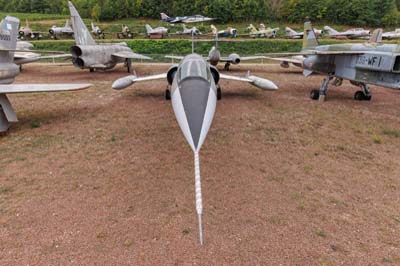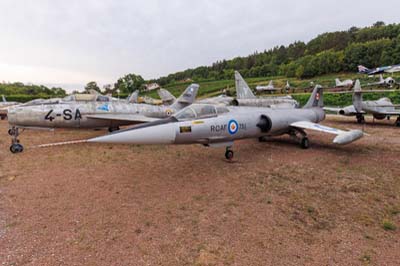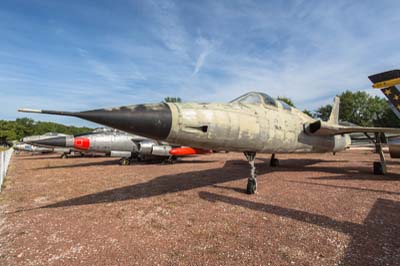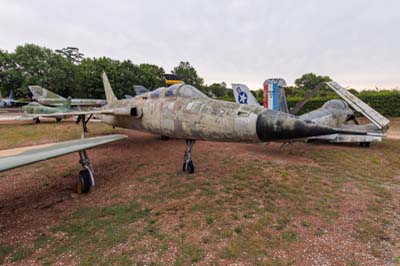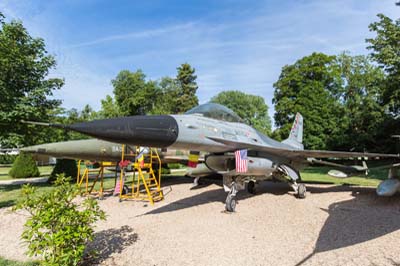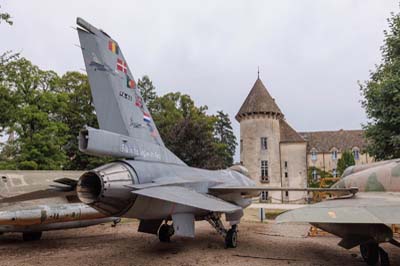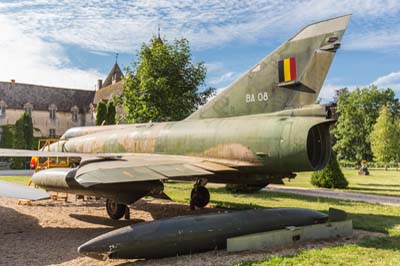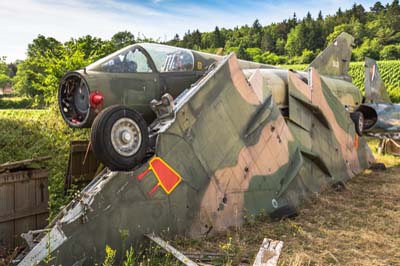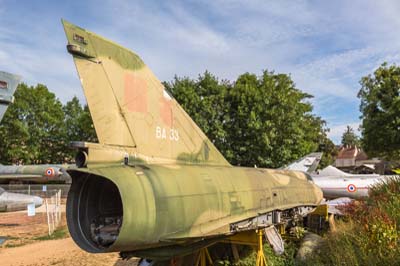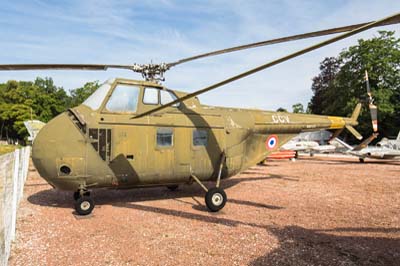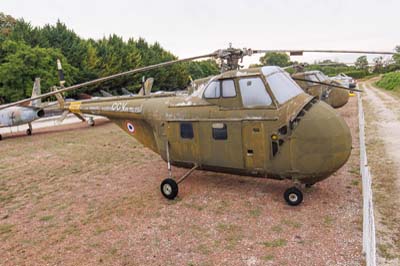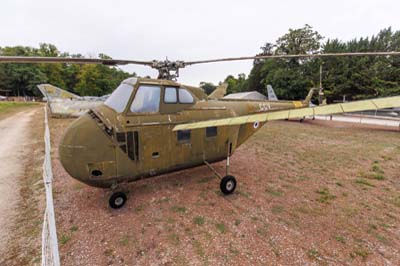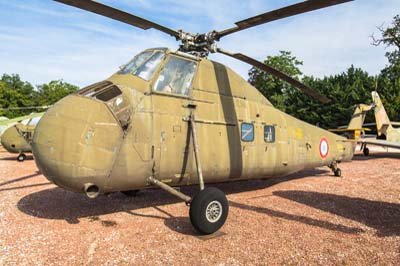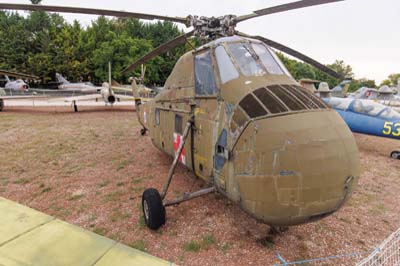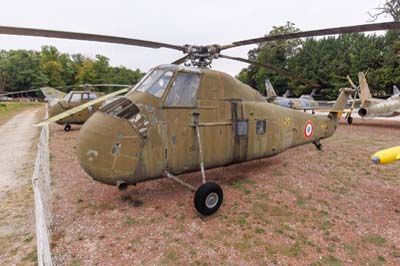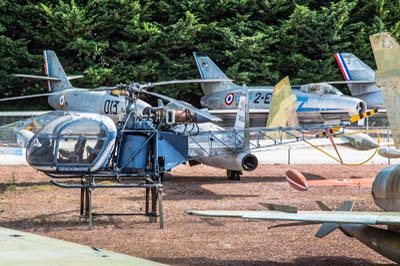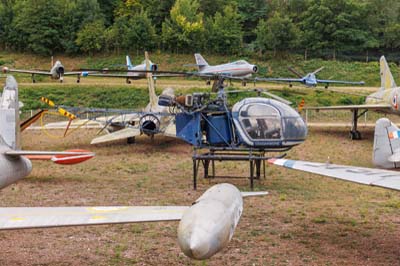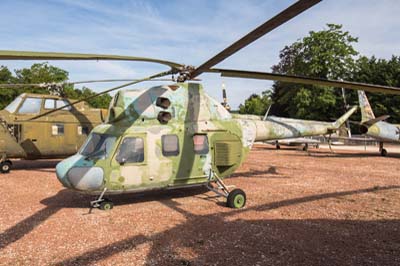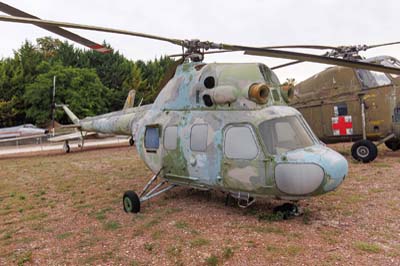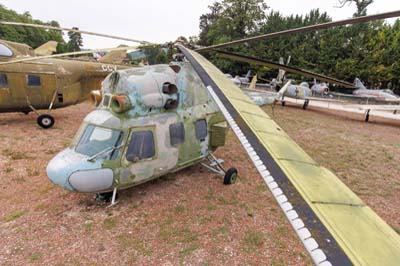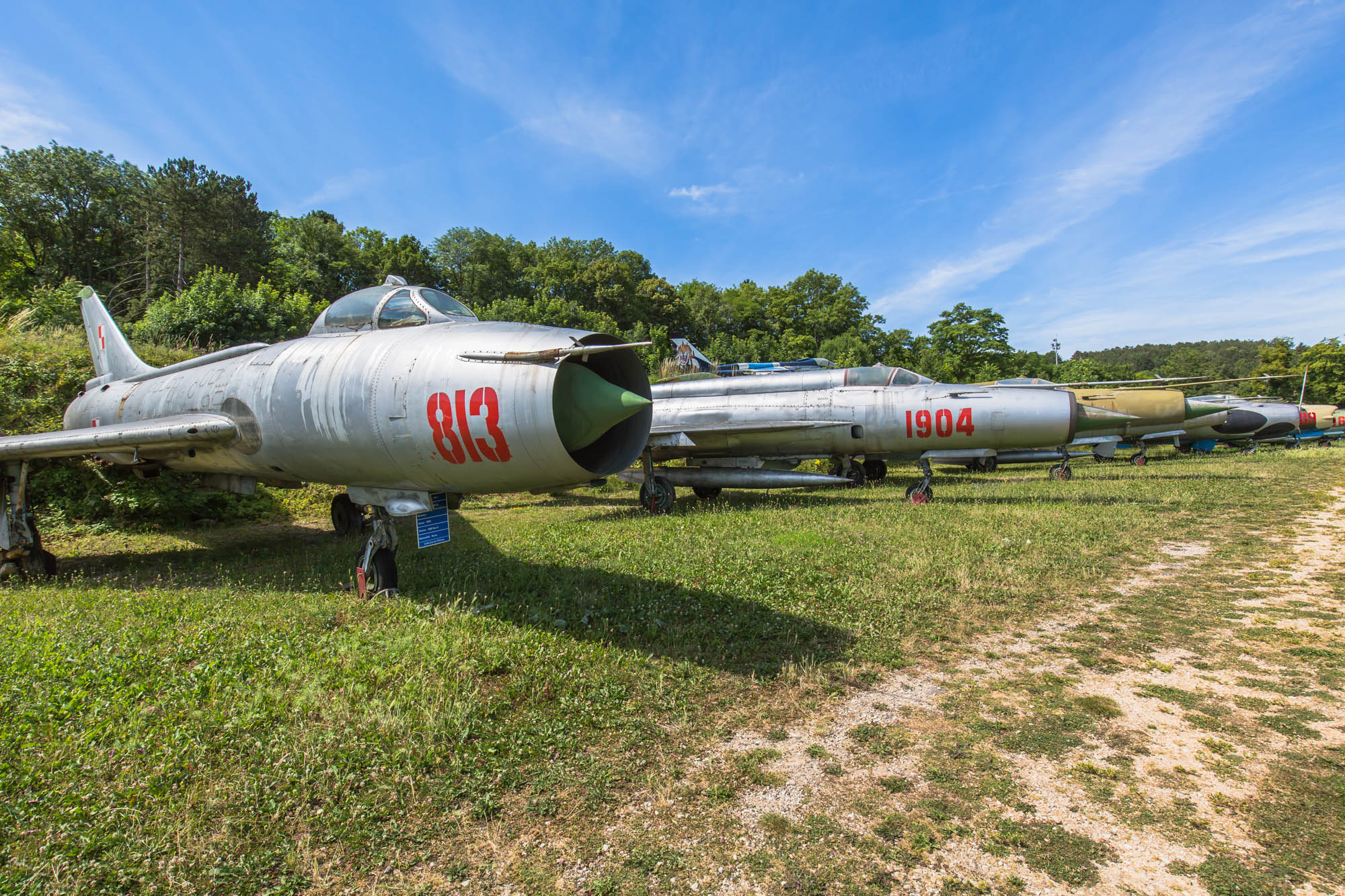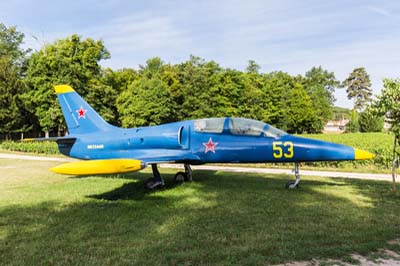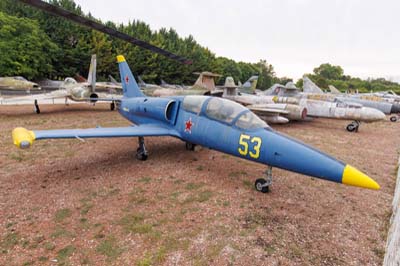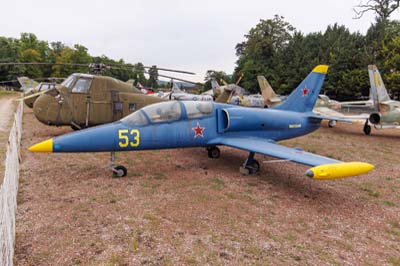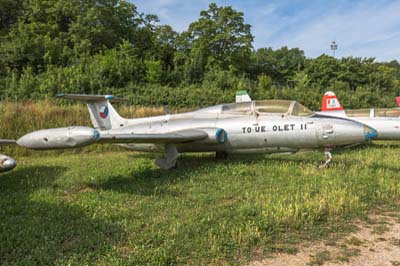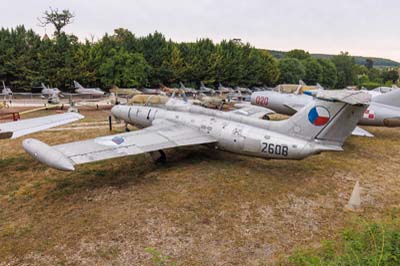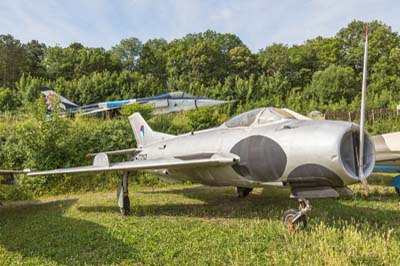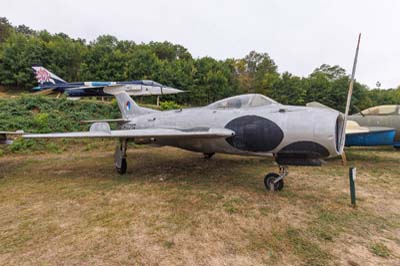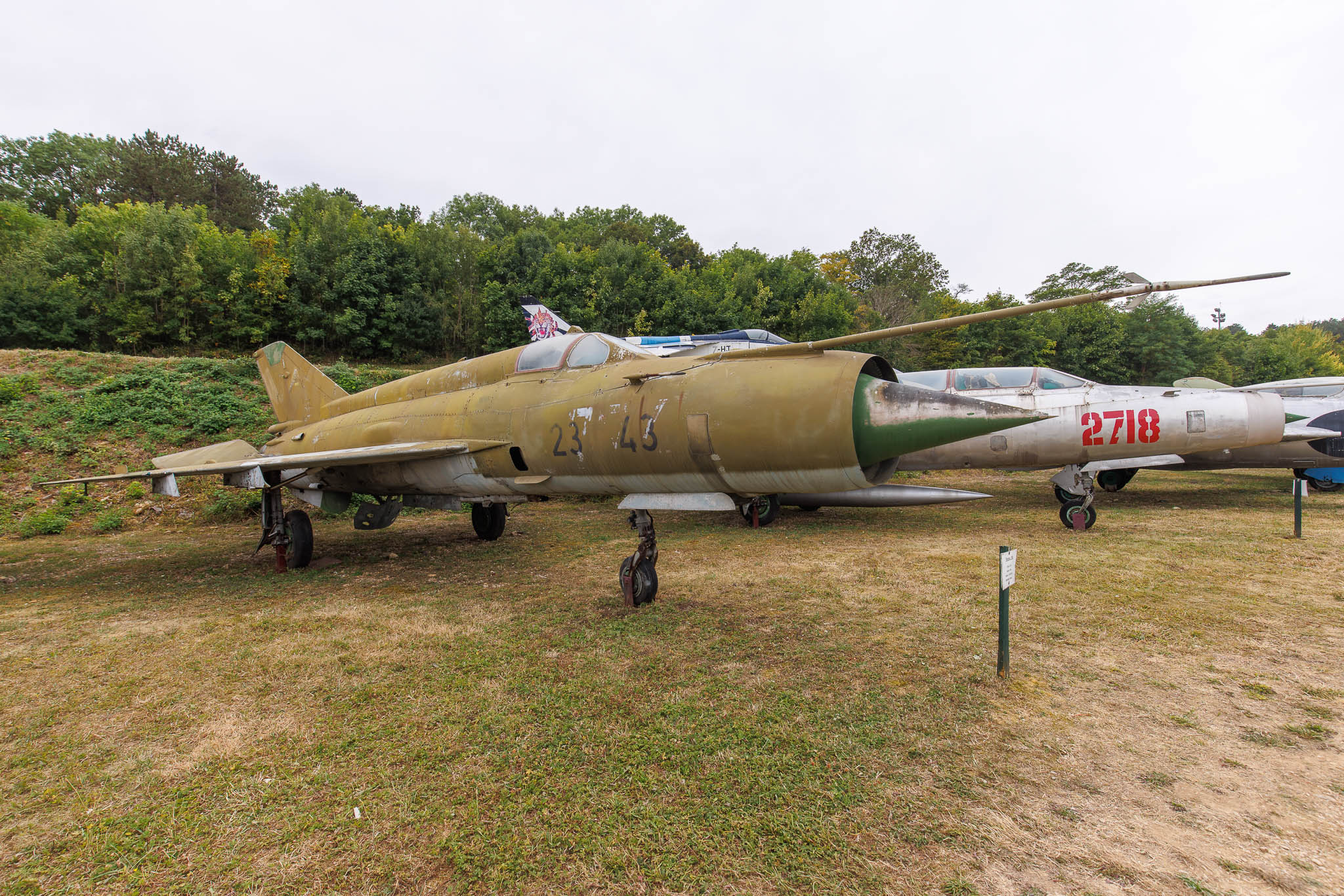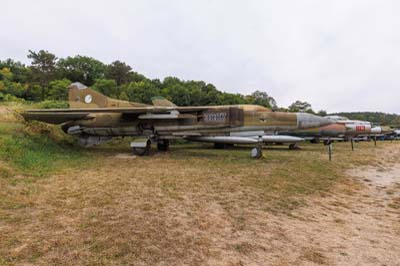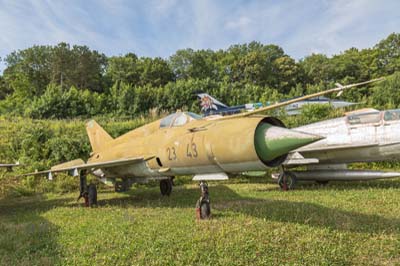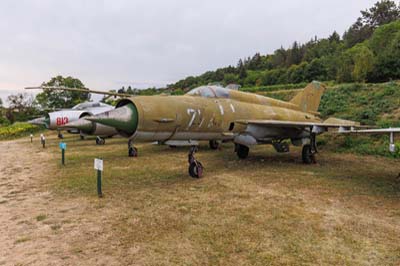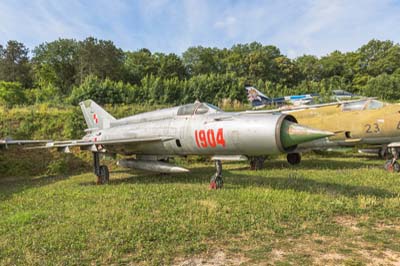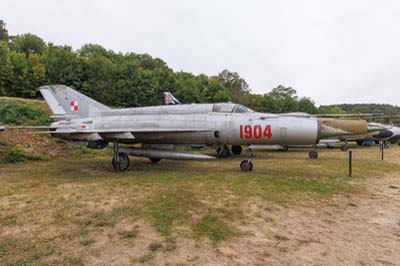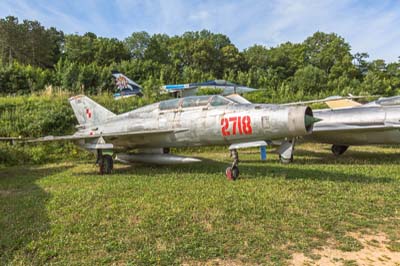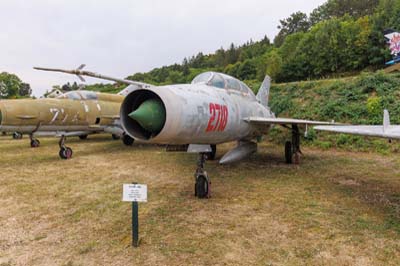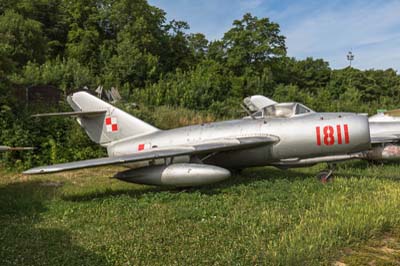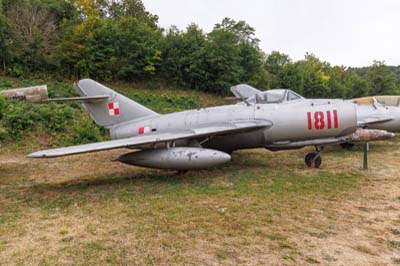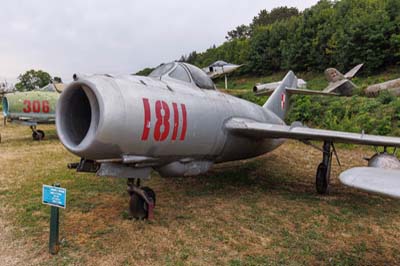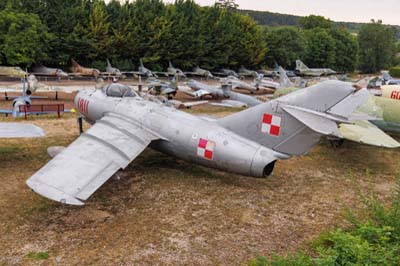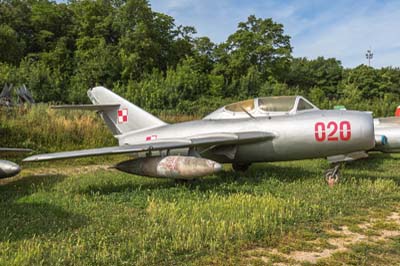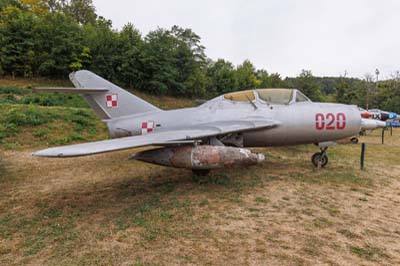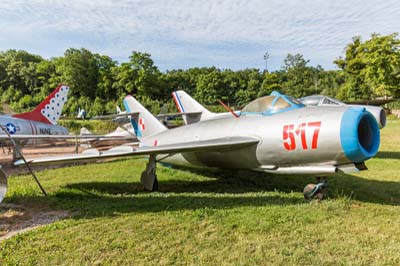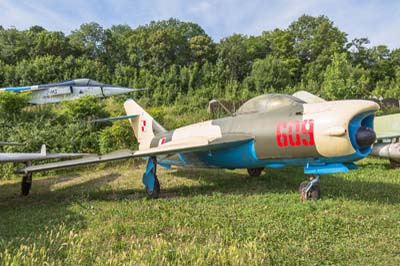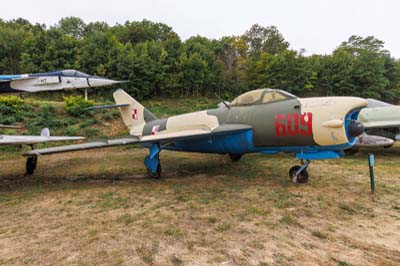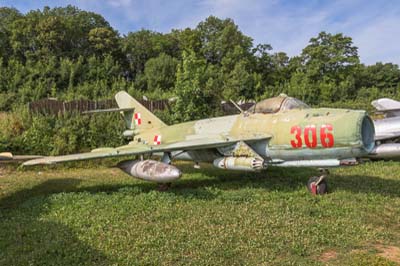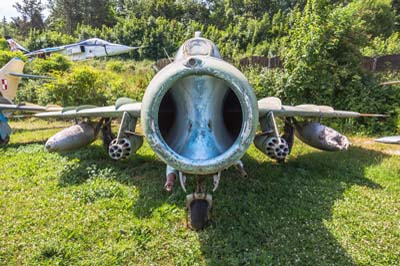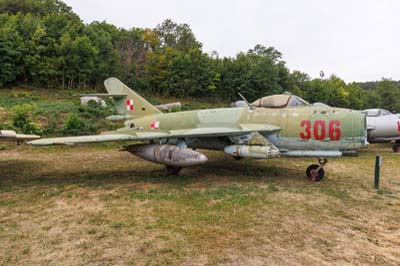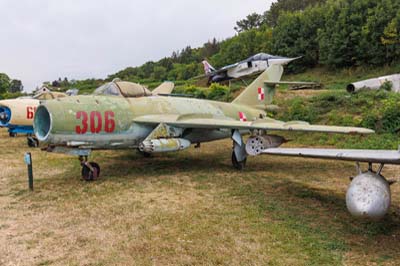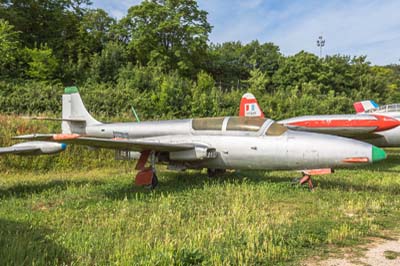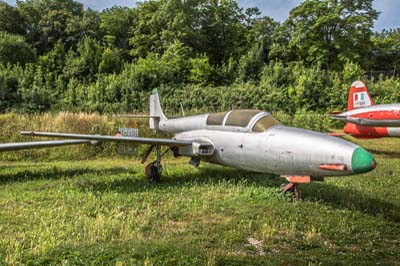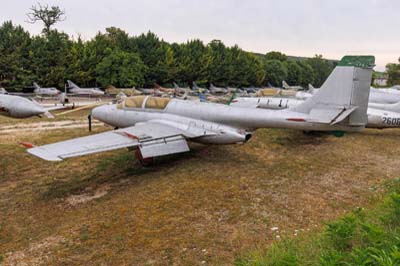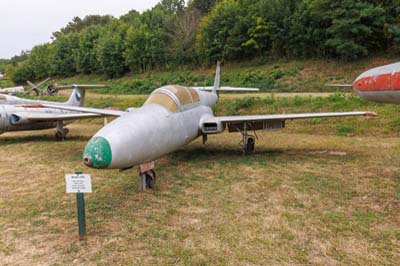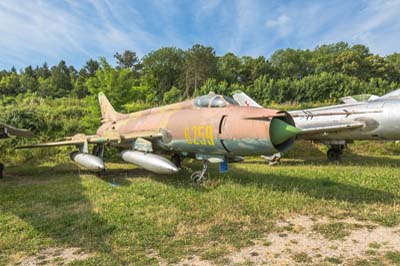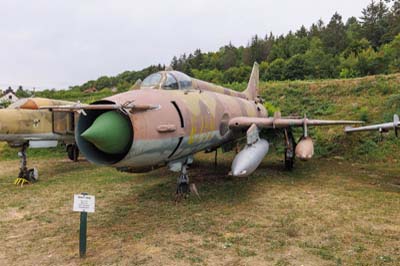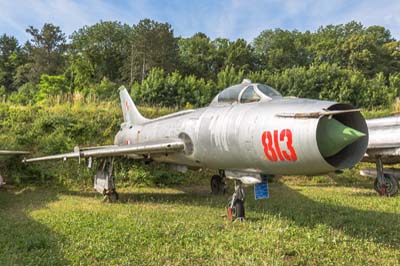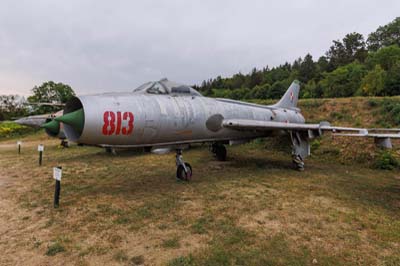Association des Amis du Musee du Château
Le Château de Savigny-Lès-Beaune, France
1991, 1998, 2015 and 2022
|
The entrance in front of the Château de Savigny-Lès-Beaune is guarded by three for Belgian Air Force jets;
Lockheed Starfighter F-104G (FX 90), General Dynamics F-16A Fighting Falcon (FA-55) and Dassault Mirage 5BA (BA 08). |
The passion of Michel Pont - A collection of rescued aircraft
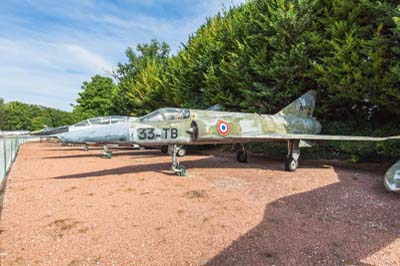 |
This Dassault Mirage IIIR No.323 '33-TB' was purchased in 1986, it was the first of many aircraft bought for Michel Ponts collection. |
The aircraft museum in the grounds of Le Château de Savigny-Lès-Beaune 20 miles from Dijon in France is in an as idyllic place as you can imagine. The château itself although now showing its age was originally built in 1340 for the Duke of Burgundy, but after most demolished it was rebuilt in the early 1600s. It is open to the public and should be viewed along with the extensive aircraft collection outside. As the château's own wine can be purchased following a wine tasting this also adds to the pleasure of visiting this wonderful place.
Wandering around the château's rooms some of which are filled with 250 or so motorbikes and 1,200 plastic models you will come across a rare Mignet HM.14 Pou du Ciel 'Flying Flea' hanging from the ceiling. It was bought in 1987 with ten other aircraft that year, including the first Mirage IVA to be privately owned, another 15 aircraft arrived in the following year.
An extensive collection of 101 aircraft, according to museum staff (and my log), of mostly fast jets has been gathered together by Michel Pont since July 1986 starting with Mirage IIIR No.323. At 83 he continues to run his wine business with his five children. The collection consists mostly of former Armée de l'air jets that were surplus to requirements from the 1980s. Michel Pont has looked further for exhibits with aircraft rescued from Belgium, Switzerland, Germany, Portugal and the United Kingdom. Some have been re-painted on-site in spurious markings and others have been restored for transfer, sale or exhibition away from the château. In more recent years some jets from the former Eastern Bloc (Poland, Czech Republic, East Germany and Ukraine) have been added. Over the years I have visited this collection there have been some changes along with the additions. The place always feels like a work-in-progress with a number of jets sitting dismantled for many years in long grass from the day they arrived.
Former pilot and racing driver Michel Pont is believed to be the world's biggest private collector of fighter planes. His reasoning behind the collection is to save aircraft from the scrap man by buying any he can find at a reasonable cost. He has acquired many duplicates and some aircraft in his collection have been joined together to create a more complete example. In having duplicates he has been able to swap them with other collections. Pont employs three technicians and they are able to refurbish two or three of the aircraft each year, "All without any financial support or subsidy", says Michel Pont.
Even though most of the aircraft in the museum are exposed to the elements (Pont is prevented under preservation rules from building a modern extension to the Château) and the paintwork is fading and peeling we should be grateful that they are still in existence because without the effort and expense incurred by the owner, many of these jets would surely have been scrapped years ago. Michel Pont confirmed this, "Some of them were doomed to be destroyed", adding "It must be said that if they were not here, these aircraft would be converted into ingots of 50kg, these would not give the same pleasure for our visitors". |
| Views from around 'Le Château de Savigny-Lès-Beaune' which Michel Pont bought in 1979 along with 20 hectares of vineyards. |
Left to right:
Henri Mignet HM.14 Pou du Ciel 'Flying Flea'. The original HM.14, designed in 1934 by Henri Mignet was probably the first home-built to be offered to the public for home construction. Following a number of fatal accidents and the discovery of aerodynamic design errors the French authorities banned it from flying in 1936, the British authorities following suit in 1937. Later HM.293 a more streamlined version with a more powerful engine were sold as home-builds in the 1960s. The anonymous example on display in the chateau was apparently found at Toucy and acquired for the collection in 1987. |
| The main collection on display |
Left to right:
Four times winner of the Le Mans 24 hour race, Henri Pescarolo visiting the château in his Robinson R-44 (F-GPHS). Michel Pont used to race Abarth cars himself and has a collection of 30 of them in another building.
Most of the collection of over 100 aircraft can be seen in this image taken from a vineyard. The Château is just visible behind the rapidly growing conifers in the background. |
| Dassault MD.450 Ouragan (230 '4-US' but marked as '450') arrived in 1987, The Avions Marcel Dassault MD.450 Ouragan was the first mass-produced French built jet fighter, taking to the air for the first time in February 28, 1949. Dassault received an order for 150 production Ouragans followed by an additional order for 200 aircraft. The first jet entered service with the Armée de l'Air in 1952, replacing the de Havilland Vampire. By 1961 the Ouragan had been replaced by the Dassault Mystère IV. |
Left to right:
Dassault MD.450 Ouragan (230 '4-US' but marked as '450').
Dassault MD.450 Ouragan (215 but marked as '251') it is painted in the markings of the Patrouille de France display team. It was previously with the Abbeville Aero Club at the Abbeville-Drucat airfield it had moved here by May 1991 marked '215 / 2-EN' at that time. As photographed in 1991 |
Left to right:
Dassault Mystere IIC (013) ex AdlA. As photographed in 1991 and 1998. |
Left to right:
Dassault 454 Mystére IVA (47 '314-TB' but now painted '37 8-QE'). The Mystère IVA was the first transonic aircraft to enter service with the Armée de l'Air, it first flew in 1952 entering service in 1953. 421 of these fighter-bombers were built. The first 50 had Rolls-Royce Tay 250 engines, the rest having a French version of the Tay known as the Hispano-Suiza Verdon.
This example was retired in 1977 when coded ''314-TB', it has more recently had the given the serial 37 and code '8-QE' representing an aircraft that had crashed in 1963, applied while at the museum.
Dassault 454A Mystére IVA (39 '8-QP') ex Armée de l'Air (AdlA, French Air Force), it was collected from Chateaudun in 1987. It had gone by June 2022.
Dassault 454A Mystére IVA (24 '8-NQ') ex AdlA. |
Left to right:
Dassault 454A Mystére IVA (289 '2-EY') ex AdlA.
Dassault 454A Mystére IVA (116 it is marked as '285' and in Patrouille de France colours) it was collected from Chateaudun in 1987. |
Left to right:
Dassault Super Mystere B2 (02) pre-production prototype which was tested with the CEV coded 'G'. |
Left to right:
Dassault Super Mystere B2 (118 '12-YS') which entered storage at Chateaudun in 1980 before moving to the Museum in 1986/7. Not seen in August 2022.
Dassault Super Mystere B2 (50 '12-ZE') as EC 2/12 'Cornwall' was restored by 2015 and has since left the museum. |
Left to right:
Dassault Super Mystere B2 (69 '12-YG').
Dassault Super Mystere B2 (60 coded '12-ZC') it was previously on the Captieux Range in 1989. |
Left to right:
Dassault Mirage IIIA (06) pre-production prototype.
Dassault Mirage IIIB (216) ex AdlA. |
Left to right:
Dassault Mirage IIIC (50 marked with code '.3.10LD') ex AdlA.
Dassault Mirage IIIE (438 '13-QI') ex AdlA. |
Left to right:
Dassault Mirage IIIE (402 '13-QL') ex AdlA. Seen in 2015 it had gone by 2022.
Dassault Mirage IIIO (001) the prototype for the Australian Air Force. |
Left to right:
Dassault Mirage IIIR (324 '2-ZM') ex AdlA.
Dassault Mirage IIIR (330 'DT') ex AdlA. Previously preserved at Cazaux it had gone by August 2022. |
Left to right:
Dassault Mirage IIIR (323 '33-TB') ex AdlA, withdrawn from service in 1986.
Dassault Mirage IIIRD (354 '33-TC') ex AdlA, withdrawn from service in 1992. |
| Dassault Mirage IVA (18 'AQ') ex AdlA. Designed as a supersonic strategic bomber and reconnaissance aircraft the prototype '01' took to the air for the first time on June 17, 1959. Prototype '02' was flown on October 12, 1961 and was accepted for production. The first production Mirage IVA was flown in December 1963. 62 Mirage IVA were built and entered service between 1964 and 1968. |
Left to right:
Dassault Mirage IVA (18 'AQ') ex AdlA. |
Left to right:
Dassault Mirage IVA (6 'AE') ex AdlA. It came from Brétigny-sur-Orge. |
Left to right:
Dassault Mirage F.1C (9 '12-ZQ') ex AdlA. The Dassault Mirage F.1 was designed as a air-superiority fighter and ground attack aircraft, designed as a successor of the Mirage III. The first prototype made its maiden flight on December 23, 1966. The Mirage F1 entered service in the Armée de l'Air in the early seventies.
Dassault Mirage 5F (9 '13-SH') ex AdlA it was withdrawn from service in 1989 and moved to the museum on September 3, 2014. |
Left to right:
SEPECAT Jaguar E (E10 '339-WF') ex AdlA. |
Left to right:
SEPECAT Jaguar A (A21 '11-YA' and A8 '11-EB') ex AdlA. |
Left to right:
SEPECAT Jaguar A (A72 '7-HJ') ex AdlA. |
Left to right:
Nord N.2501 Noratlas (92 'T') ex AdlA.
Nord N.2501 Noratlas (149 joined to 151) ex AdlA. |
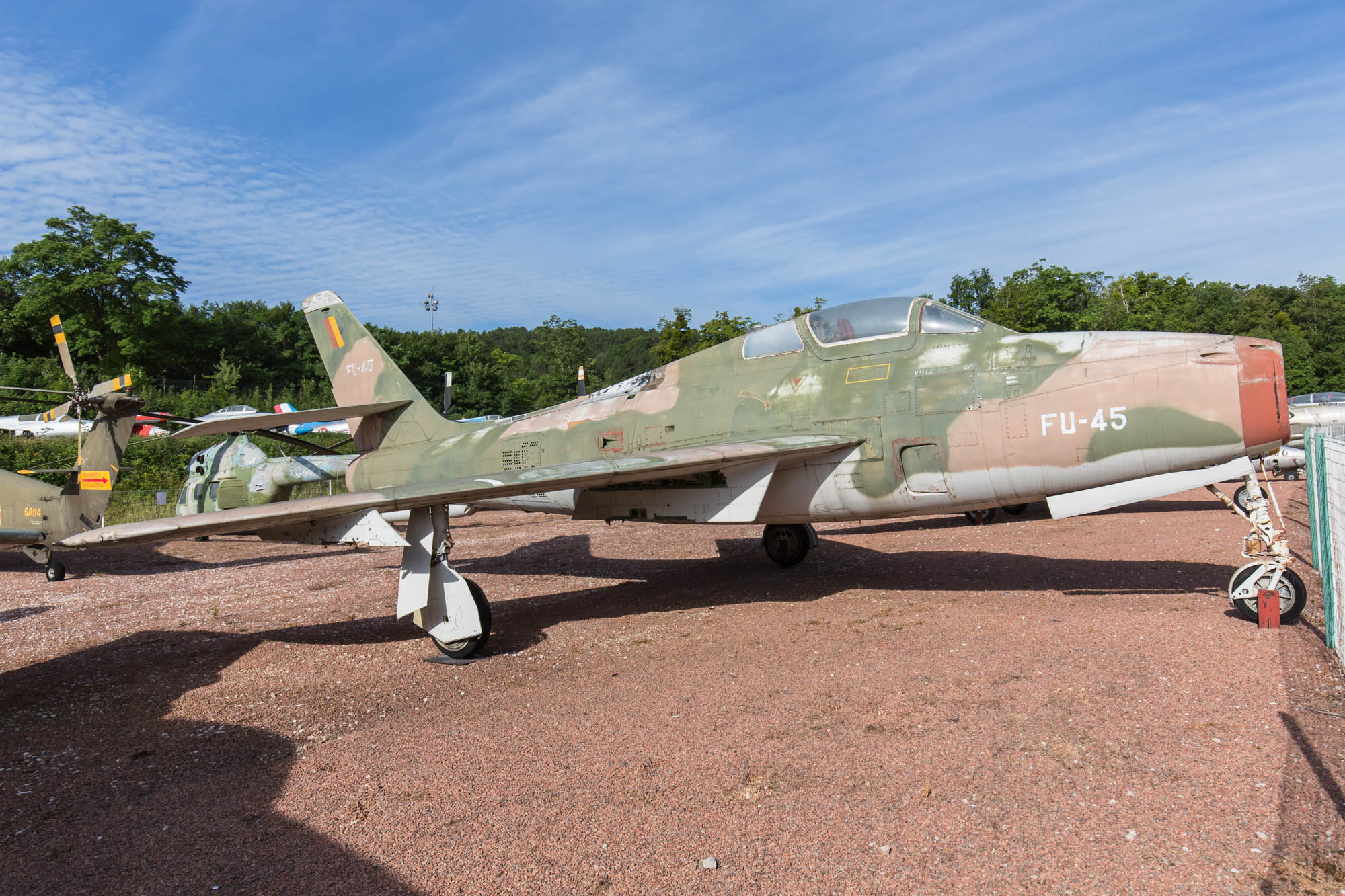 |
Left to right:
Republic F-84F Thunderstreak (FU-45). The F-84F was developed after the F-84G and was a vastly different aircraft. It had 40 degree swept back wings, instead of the straight wings of the F-84G. It was originally designated the YF-96A and was capable of speeds of 695 m.p.h. The F-84F was supplied to NATO countries, of the 2,711 built 1,301 went to Europe. Belgium took delivery of 197 aircraft from 1955 (serials FU-1 to FU-197) to replace the F-84G. They remained in service until 1972. These in turn were replaced by the F-104G Starfighter starting from the 1960s. The aircraft on display was withdrawn from service 1970 and stored at Koksijde AB, it later went to Florennes AB to be used as decoy before it was rescued by the museum in the mid 1980s. As photographed in 1991.
Republic F-84F Thunderstreak (FU-97) ex Belgian Air Force it was withdrawn from service in 1971 and stored at Koksijde Air Base before being transferred to Bierset AB where it was used as a decoy. It has recently been painted in spurious Armée de l'Air markings with a code of '4-VF'. |
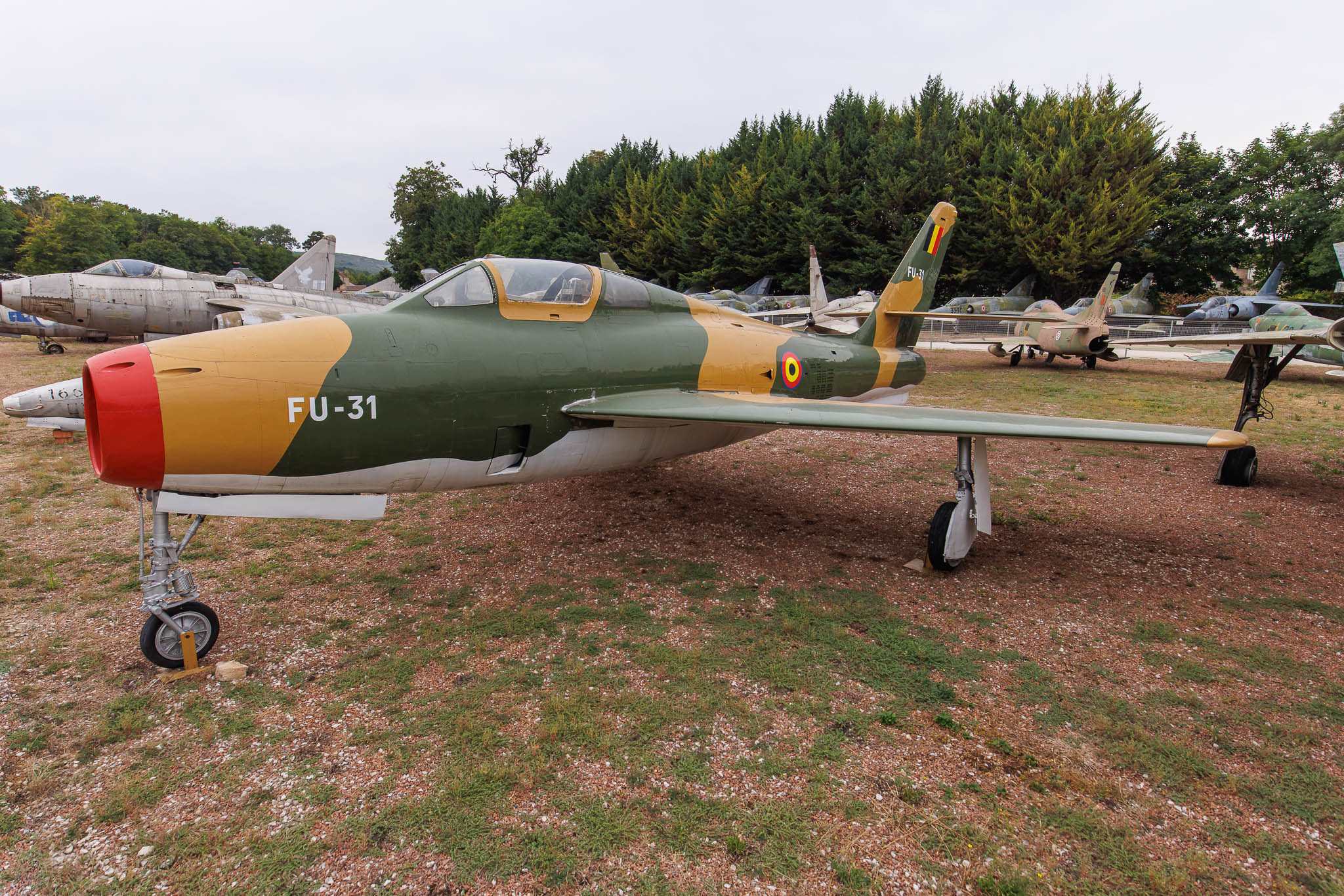 |
Left to right:
Republic F-84F Thunderstreak (FU-31) was withdrawn from service in 1971 and stored at Koksijde Air Base before being transferred to Bierset AB where it was used as a decoy. It had been languishing in the long grass for decades until at least June 2017. By May 2019 FU-31 was on display having been restored, assuming this is in fact the same air frame. |
Left to right:
Republic F-84E Thunderjet (51-9572 'FS-669') ex AdlA.
Republic F-84F Thunderstreak (29003 coded '4-SA') ex AdlA it has been fitted with the rear fuselage from (FU-21) a Belgian Air Force jet. The Armée de l'Air received its first Thunderstreaks in 1955 a year later they deployed the F-84F during the Suez crisis. The F-84F were replaced by the Mirage III in the mid 1960s. As photographed in; 1998 and 1991. |
Left to right:
Republic RF-84F Thunderflash (FR-26). The RF-84F was the first jet aircraft to be designed solely for photo-reconnaissance, which could be achieved both day and night. The Belgian Air Force took delivery of 34 of these innovative aircraft (serials FR-1 to FR-34). They entered service in 1955, operating with 42 Squadron until there final retirement in 1972. The F-84s flew in the silver colour scheme until 1967 when a Vietnam camouflage scheme was applied. The museums example was rescued by Michel Pont from a scrapyard in Kalken, Belgium in 1988. |
Left to right:
Republic F-84G Thunderjet (51-10838 later 5216 Portuguse Air Force (Força Aérea Portuguesa), it is marked as '3-IX / 110885'). The F-84E Thunderjet first flew in 1949 with 843 being built. The F-84G entered service in 1951, 3,025 were built with 1,936 being transferred to NATO countries in Europe. As photographed in 1984 at Alverca, Portugal. |
Left to right:
Republic F-84G Thunderjet (9978 'KP-X' Royal Danish Air Force ex 52-3057). |
Left to right:
Canadair CL-13 (F-86) Sabre Mk6 (JA-339) ex West German Air Force. The North American F-86A set its first official world speed record of 670 miles per hour (1,080 km/h) in September 1948. The F-86 was also manufactured by Canadair in Canada as the CL-13 Sabre. The WGAF flew 75 Canadair Sabre Mk 5 and 225 Canadair Sabre Mk6 from 1957, the last Mk6 used for training was retired in 1983. As photographed in 1998.
North American F-86D-30-NA Sabre (51-5977 painted as '52-3667 / FU-667') ex USAF (from 1954) and ex Royal Danish Air Force (from 1958 to 1966) as serial F-977 ex Ugglarp museum and Svedinos Bil-Och Museum in Halmstad, Sweden. Arrived Savigny after 2015.
|
Left to right:
NATO invited European aircraft manufacturers in 1953 to design a 'Light Weight Strike Fighter'. Resulting from this competition the G.91 was the most successful, with orders from the West German, Italian and Portuguese air forces. Aeritalia built 174 for the Italian and 144 for the West German air forces. A consortium of Messerschmitt, Dornier and Heinkel built 294 in West Germany. The West German example on display was a Strike Reconnaissance version of the 'Gina' the Portuguese is a two-seat trainer variant.
Fiat G-91 R/3 (32+43) ex West German Air Force.
Fiat G-91 T/3 (1801) ex Portuguese Air Force. |
Left to right:
North American TF-100F Super Sabre (GT-949) ex Royal Danish Air Force painted as 'Nine' of the USAF display team the Thunderbirds. |
Left to right:
North American F-100D Super Sabre (42130 '11-YF') with Armée de l'Air until 1978 and on to Savigny in 2006, 42130 is fitted with the tail of 54-2235. 100 F-100s, including 12 F-100F two-seats, were delivered to the AdlA between 1958-59 from the US. As photographed in 1991.
North American F-100D Super Sabre (42130 '11-YF') with AdlA until 1978. |
Left to right:
North American F-100D Super Sabre (63937 '11-YH') with AdlA until 1978 it arrived at museum in 1988. |
Left to right:
Canadair T-33AN Silver Star (21029 '314-YG'). The Lockheed T-33A Shooting Star was based on the single seat P-80, first flying in 1948. The example on display was supplied to the AdlA from 1951. EAC 314 received its first jets these were later supplemented with the Dassault MD-450 Ouragan (1957 to 1962) and the Dassault Mystère IV (1961 to 1973). The T-33ANs however outlasted the French built jets and were not withdrawn until 1981 after 30 years of service. |
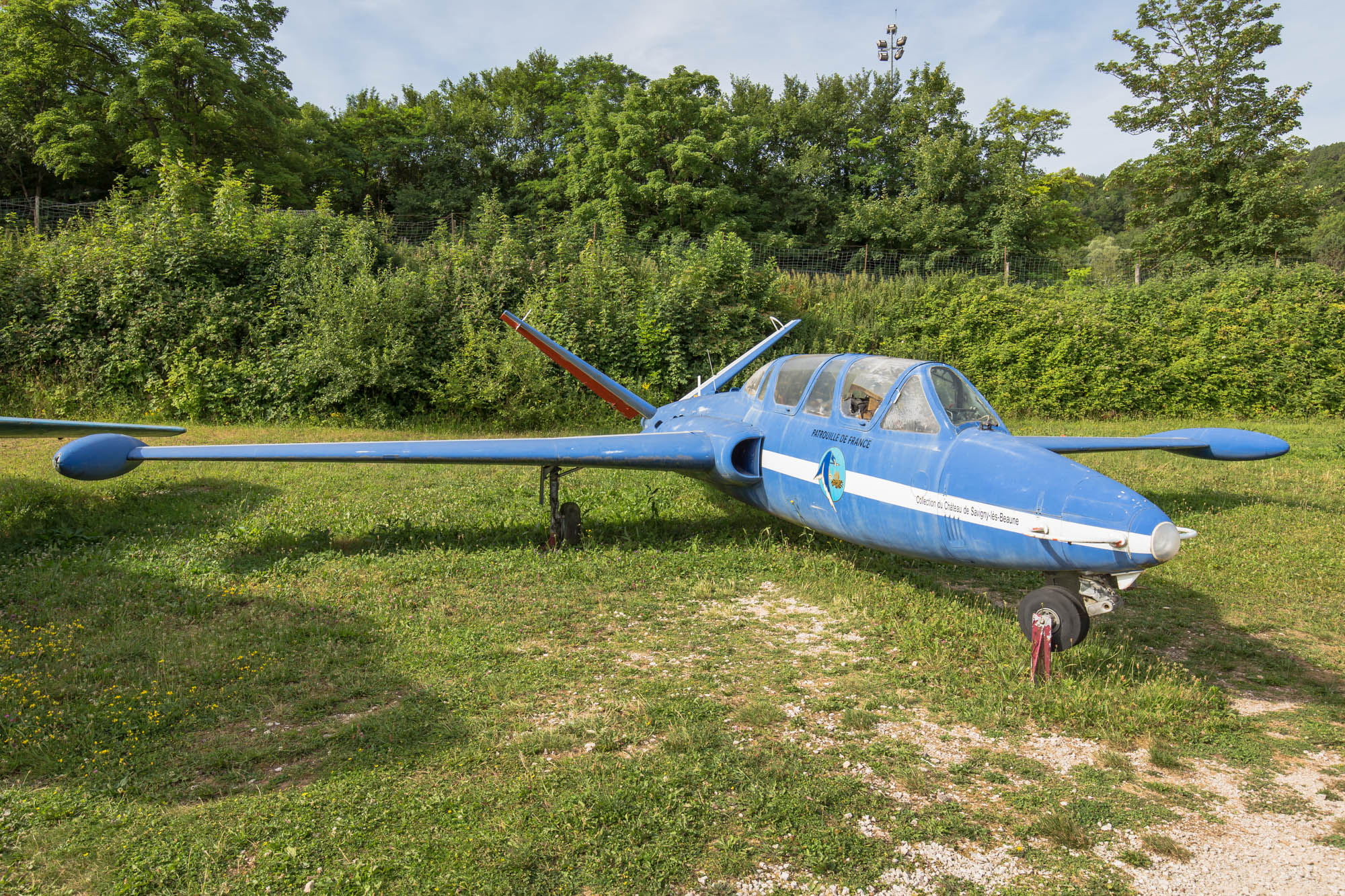 |
| Fouga CM.170R Magister (14 F-WGPU 'UJ' marked as '493' in Patrouille de France markings). The CM.170R Magister was designed as a jet trainer to NATO specifications in the 1950s. It is fully aerobatic and served with the French 'Patrouille de France' and Belgian 'Red Devils' display teams for many years. A total of 589 Magisters were built between 1952 when the prototype first flew and December 1969. The Armée de l'Air having taken delivery of 473 examples. The Patrouille de France flew the Magister until they converted to the Alpha Jet. |
Left to right:
Fouga CM.170R Magister (14 F-WGPU 'UJ' marked as '493' in Patrouille de France markings).
Fouga CM.170R Magister (MT-33 of Belgian Air Force). The CM.170R Magister was designed as a jet trainer to NATO specifications in the 1950s. It is fully aerobatic and served with the French 'Patrouille de France' and Belgian 'Red Devils' display teams for many years. The Belgium Air Force took delivery of 54 Potez-Fouga built Magisters from 1960 with another five refurbished (ex Luftwaffe) Messerschmitt built aircraft arriving between 1960 and 1962. They remained in service till 1998. The Magister serials were MT-1 to MT-50 with some serials being used twice following write-offs. |
Left to right:
Fouga CM.170R Magister (166 '10-KK') ex AdlA. |
Left to right:
Fouga CM-175 Zephyr (2) ex French Navy. The navalised version of the Magister first flew in July 1956. |
Left to right:
Morane-Saulnier MS.760 Paris (46) was assigned to the French Navy (Aéronavale) from 1959 to 1992 when it was damaged beyond repair at Istres. The prototype flew for the first time on July 29, 1954 and the first production aircraft on February 27, 1958. |
Left to right:
North American AT-6C Harvard IIa (1527 ex 41-33553, to EX580 RAF, to South Africa as 7248 and then to Portugal as 1527). As photographed at Alverca, Portugal in 1984. |
Left to right:
Bréguet Br.1050 Alizé (04). The Alizé was carrier-based and was used for anti-submarine warfare by the French Navy (Aéronavale). This example is the first of two pre-production aircraft, it arrived at Savigny on September 9, 2002. |
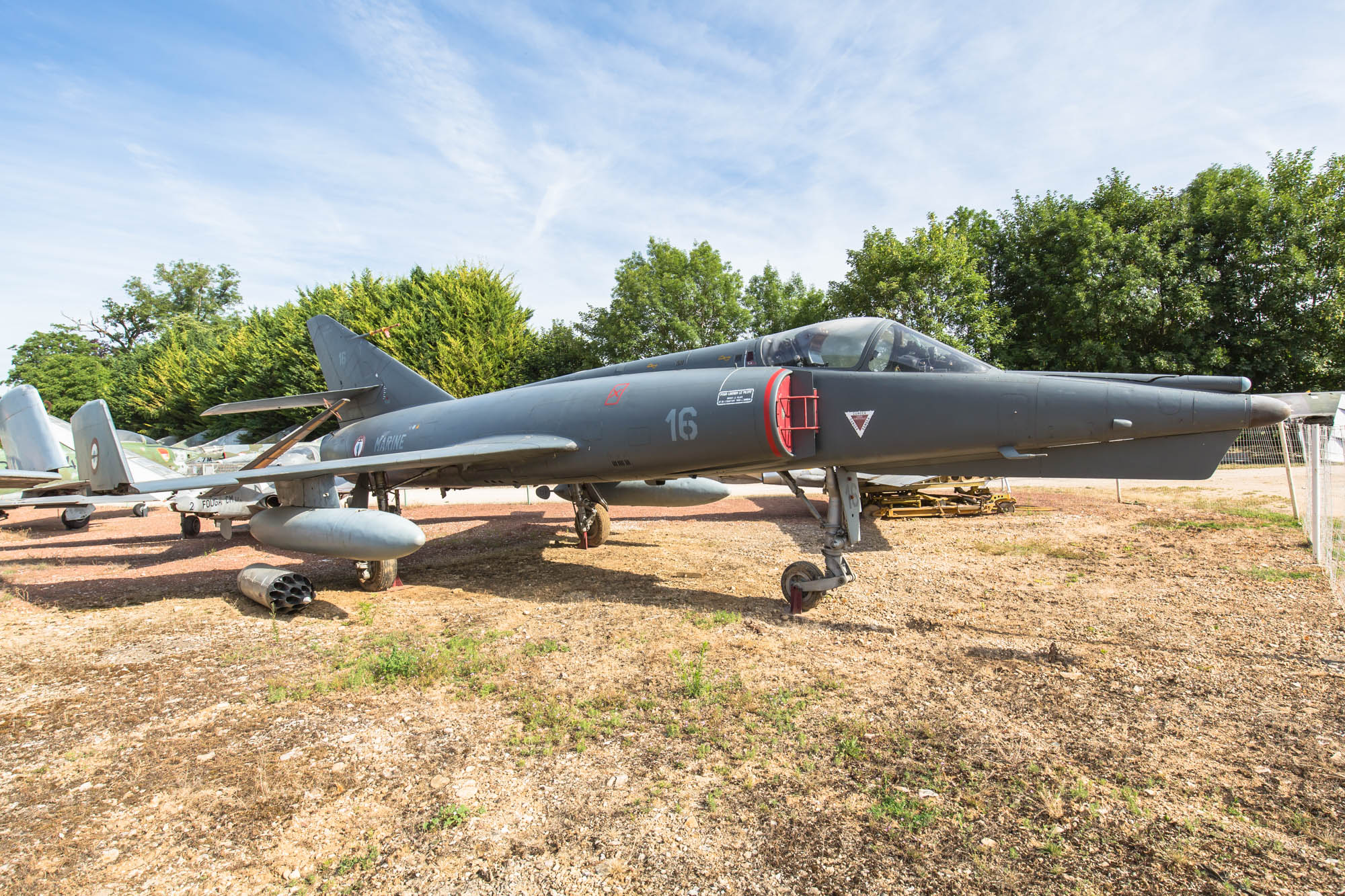 |
Left to right:
Dassault Étendard IVM (16) of French Navy (Aéronavale). The Dassault Étendard IV is a supersonic carrier-borne strike fighter designed for the French Navy (Aéronavale). It was first demonstrated in 1958 resulting in an order for 69 fighter aircraft, designated Étendard IVM and 21 reconnaissance versions designated Étendard IVP.
The example on display was preserved at ASPAA Brieve-la-Gaillarde until Michel Pont bought it for 17,000 Euro in September 2014. At the time of the purchase he said, "I am passionate about airplanes, it even borders on madness. It [Etendard No.16] is simply missing from my collection of aircraft, it will increase my collection to 101 aircraft." The museum had No.60 until recently on display here but No.16 has been put in its place. |
Left to right:
Dassault Étendard IVM (16) ex French Navy (Aéronavale). |
Left to right:
Dassault Étendard IVMP(166) it was previously at Cuers. |
Left to right:
LTV F-8P Crusader (35) ex French Navy (Aéronavale). The Crusader was a single-engine, supersonic, carrier-based air superiority jet aircraft built by Vought for the United States Navy and the US Marine Corps. The prototype flew in February 1955. Deliveries to the Aéronavale (Flotille 12F) started in October 1964 and continued until February 1965, the Crusader was eventually replaced by the Rafale M in 2000. |
Left to right:
LTV F-8P Crusader (1 marked as 150879 'AH-204') as above this aircraft served with the French Navy (Aéronavale). |
| SNCASO (Sud Aviation) SO.4050N Vautour IIN (304). The Vautour was designed as a bomber, interceptor and attack aircraft. 112 examples (IIA, IIB and IIN variants) entered service with the Armée de l'Air in 1958 and was not withdrawn from frontline service until 1979. The IIA was a single-seat, long-range attack aircraft, the IIN a two-seat, all-weather interceptor and the IIB was a two-seat bomber with glazed nose position for bombardier/observer. Of the 149 aircraft built 28 were supplied to Israel. As photographed here in 1998. Sister aircraft No.335 photographed when in service with CEV at Bretigny in 1986, it arrived at Savigny in September 1988. Transferred to the Musee Europeen de lAviation de Chasse at Montelimar-Ancone in April 2017. |
Left to right:
Sud-Ouest Aviation (SNCASO) SO.4050 Vautour IIN (304 callsign F-ZADR). Delivered in 1957 it served with the CEV (as 'DR') at Bretigny since 1957. Arrived at the museum in September 1988. Transferred to the Musee Europeen de lAviation de Chasse at Montelimar-Ancone in April 2017.
Sud-Ouest Aviation (SNCASO) SO.4050 Vautour IIA (2 ex '92-AB'). Delivered in 1956 it became a ground trainer at Rochefort AB in 1970 and later was preserved at Cazaux AB. |
Left to right:
Sud-Ouest Aviation (SNCASO) SO.4050 Vautour IIA (2 '92-AB'). |
Left to right:
Gloster Meteor TT.20 (H-512 Royal Danish Air Force, RAF WM395 registered SE-DCF). Rear fuselage only found in storage, the cockpit had been on display inside a building here previously. It was impounded at Gosseilies in 1969 along with SE-DCF as they were thought to be bound for embargoed Biafra and remained in open storage for 19 years. They were both acquired for the Museum in 1986 arriving here in June 1988. As photographed in 1991. |
Left to right:
Gloster Meteor TT.20 (H-508 Royal Danish Air Force, RAF WM391 registered SE-DCH). The nose is/was on display in one of the buildings onsite at the museum. |
Left to right:
Gloster Meteor NF.11 (NF11-24 ex WM301 RAF). Development of the NF.11 Night Fighter variant started in 1948, with 335 being built by Armstrong-Whitworth. As photographed in 1991. To Dugny - Le Bourget, Paris for restoration by September 2020. |
Left to right:
Gloster Meteor T.7 (F6 ex AdlA) arrived here in January 1988. As photographed in 1991. |
Left to right:
English Electric Lightning F.1A (XM178 'Y') ex 23 Squadron RAF. |
The shelter was built to protect their delicate plywood skins.
Left to right:
de Havilland DH-115 Vampire T.55 (185 Irish Air Corps) ex AdlA, arrived in 1987 from the Musee de l'Air. The Vampire first flew in 1943. The Vampire T.11 was produced from 1950 remaining in service till 1967 with the RAF. |
Left to right:
de Havilland DH-115 Vampire FB.6 (J-1178 ex Swiss Air Force).
de Havilland DH-112 Venom FB.54 (J-1545) ex Swiss Air Force. The first Venom prototype flew on September 2, 1949. It served with the Royal Air Force as a single-seat fighter-bomber and two-seat night fighter. The 22 FB.54s built were purchased by Venezuela and Switzerland in the 1950s. |
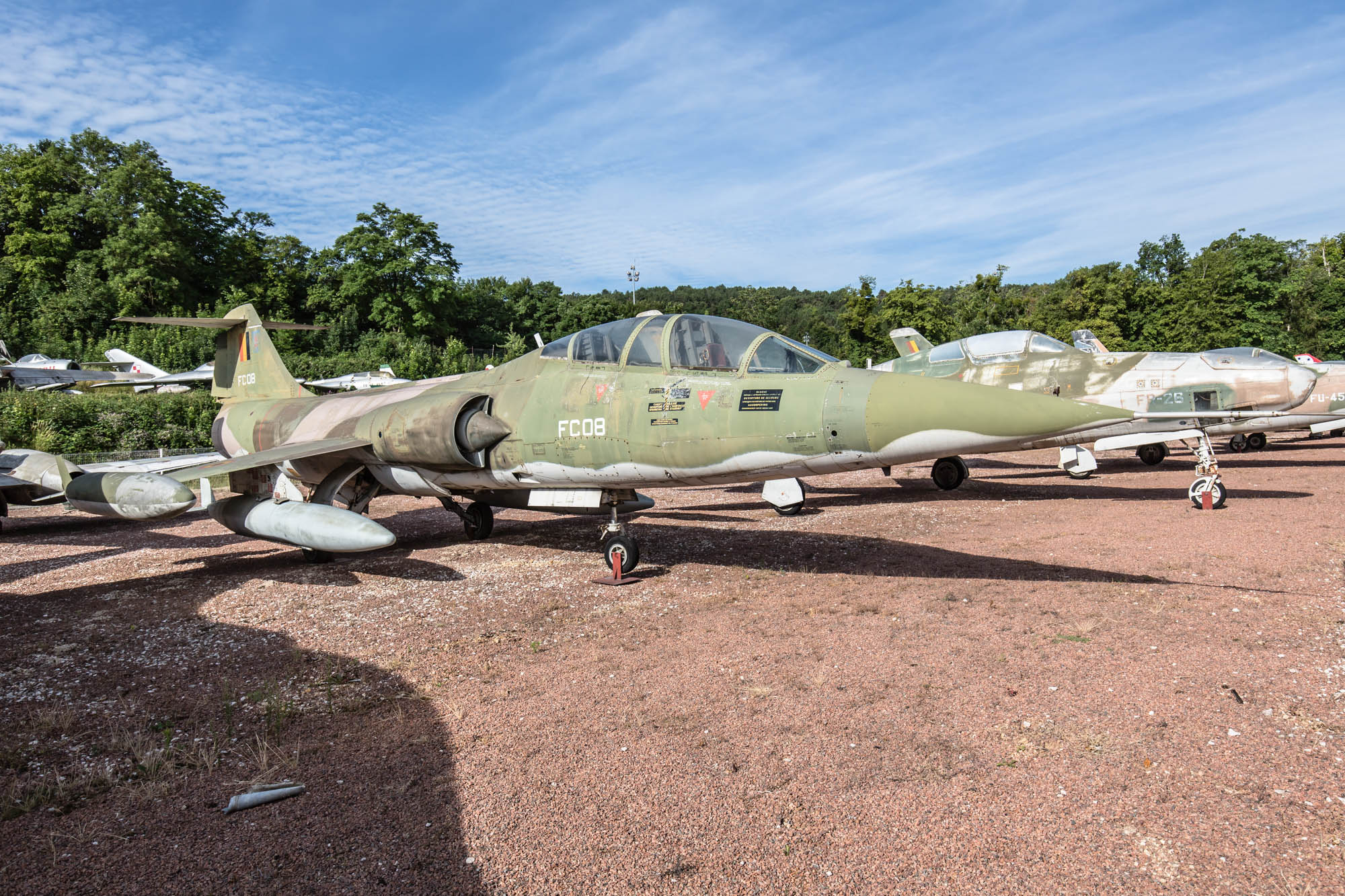 |
| Lockheed TF-104G Starfighter (FC08) ex Belgian Air Force. The first F-104A Starfighter flew in 1954 and production of this multi-role, all-weather strike fighter was started in many of the countries which adopted this unique aircraft, such as Fokker in Holland, Fiat in Italy, Messerschmitt in Germany and SABCA in Belgium. The two-seat TF-104G Starfighter's were manufactured by Lockheed. The F-104G had a maximum speed of 1,328 m.p.h. at 35,000 feet and could climb to 90,000 feet. The Belgian Air Force were supplied 101 F-104Gs (serials FX 1 to FX 100). An extra one was required to replace FX27, which crashed during testing. They were delivered between 1963 and 1965. 12 TF-104Gs (serials FC01 to FC12) were delivered in 1965. The Starfighter was notoriously difficult to fly in some situations. The Belgian Air Force lost 41 F-104Gs and three TF-104Gs before their retirement in 1983. |
Left to right:
Lockheed TF-104G Starfighter (FC08) ex Belgian Air Force.
Lockheed F-104G Starfighter (FX 90) ex Belgian Air Force it is on display in front of the Château. |
Left to right:
Starfighter CF-104 (104799 Royal Canadian Armed Forces) displayed as '12751 from an earlier era to when it was retired'. |
Left to right:
Republic F-105F Thunderchief (63-8357). It was a Mach 2 supersonic fighter-bomber used by the United States Air Force. The YF-105A prototype first flew on 22 October 1955. The F-105 flew the majority of strike bombing missions during the early years of the Vietnam War before being withdrawn. A total of 833 F-105s were completed before production ended in 1964, 143 of which were built were the two-seat F-105F trainer variant many of which were converted into the anti-radar 'Wild Weasel' version.
The example on display was retired in 1981 and transferred to Davis-Montham AB (MASDC), moving to Hahn in 1984 it was used as a battle damage repair trainer. In 1985 it was sold as scrap to the Hermeskeil Museum and later traded with Savigny in 1995.
General Dynamics F-16A Fighting Falcon (FA-55). The YF-16 first flew in 1974, entering service a year later. To date over 4,400 F-16s have been delivered to at least 23 countries, with production in Europe in both Holland and Belgium. SABCA initially received an order to build 96 single seat F-16As, which was increased in 1983 to 136 (serials FA-01 to FA-136) and 20 (increased to 24) two-seat F-16Bs (serials FB-01 to FB-24). The assembly line opened in 1978. The first F-16 a two-seat, was delivered in 1979, by 1981 the first squadron (349) was fully operational. The final aircraft was delivered in 1985. The example on display (FA-55), had a period of storage with another 30 redundant F-16s, at Weelde from 1994. |
Left to right:
Dassault Mirage 5BA (BA 08). The Mirage 5 is based on the Mirage 3, but having simplified avionics. 106 Mirage 5s were delivered to Belgium, comprising of; 63 BA 'strike', 16 BD 'two seat' and 27 BR 'reconnaissance' variants. Most of them were license built by SABCA/Avions Fairey at Gosselies and were produced from 1970. The aircraft exhibited (BA 15) has the tail badge of 8 Squadron. The Mirage 5 was withdrawn from service in 1994 many being transferred to Weelde for storage.
Dassault Mirage 5BA (BA 33), arrived at Savigny in 2011, transferred to To Chateau de Bosc (Bosc Castle), Saze, Languedoc-Roussillon in 2017.
Dassault Mirage 5BR (BR 24 Belgium Air Force) has now been painted in spurious Armée de l'Air markings. Arrived at Savigny in 2011, transferred to Creil with the wings of BD13 in 2016. |
Left to right:
Westland S.55 Whirlwind HAR.2 (WAD130 'CCV' but marked 'WAD129') ex ALAT. |
Left to right:
Sikorsky S-58/H-34A Choctaw (SA114 '68-UF') ex AdlA. |
Left to right:
Aerospatiale (Sud Aviation) Alouette II (1247) ex Gendarmerie. The Alouette first flew in 1955, it was the first Gas turbine powered helicopter, by 1975 1500 had been built. |
Left to right:
Mil Mi-2M (0625) ex Polish Air Force. |
| Part of the line-up of former Eastern Bloc aircraft which were acquired mostly by swapping surplus aircraft with other collectors. |
Left to right:
Aero Albatros L-39C (132029 and RA-3366K) ex Ukrainian Air Force, marked 53 yellow. |
Left to right:
Aero Let L-29R 'Delfin' (2608) ex Czechoslovak Air Force (Ceskoslovenské Vojenské Letectvo) from the Zruc Museum. The L-29 entered operational service in 1963, with production continuing until 1974 at the Aero Vodochody factory in Czechoslovakia.
Mikoyan-Gurevich MiG-19S (0219) ex Czech Air Force arrived from the Zruc Museum. |
Left to right:
Mikoyan-Gurevich MiG-23MF (3887) ex Czechoslovak Air Force (Ceskoslovenské Vojenské Letectvo) arrived from the Zruc Museum. Production commenced in 1970 in the Soviet Union and reached over 5,000 aircraft built.
Mikoyan-Gurevich MiG-21MF (23+43) ex German Air Force (Luftwaffe). It's former East German Air Force ((Deutsche Demokratische Republik)) serial of 774 is now showing through the faded paint. |
Left to right:
Mikoyan-Gurevich MiG-21M (1904) ex Polish Air Force (Polskie Sily Powietrzne).
Mikoyan-Gurevich MiG-21MU-600 (2718) ex Polish Air Force. As photographed in 1991. |
Left to right:
PZL-Mielec SBLim-2 'Midget' (MiG-15) (1811) ex Polish Air Force (Polskie Sily Powietrzne). |
Left to right:
PZL-Mielec SBLim-2M 'Midget' (2-seat MiG-15UTI) (720 marked '020') ex Polish Air Force. As photographed in 1991.
PZL-Mielec Lim-5P 'Fresco' (MiG-17F) (517) ex Polish Air Force. |
Left to right:
PZL Lim-5P (609) ex Polish Air Force. |
Left to right:
PZL Lim-6bis (306) ex Polish Air Force. |
Left to right:
PZL TS-11 100bis (323) ex Polish Air Force. |
Left to right:
Sukhoi Su-20R (6259) ex Polish Air Force from Bydgoszcz.
Sukhoi Su-7BKL (813) ex Polish Air Force. |
